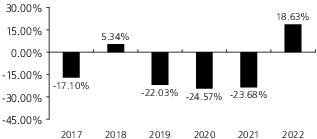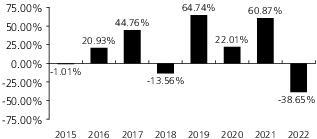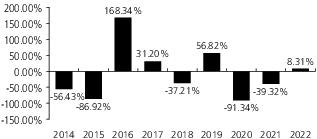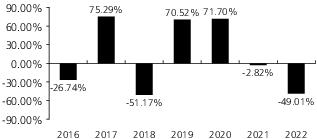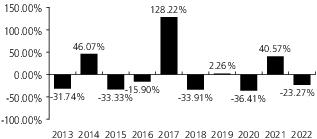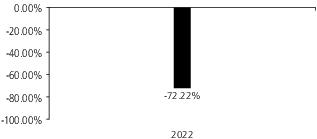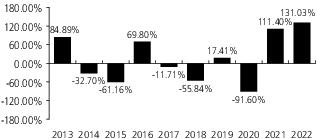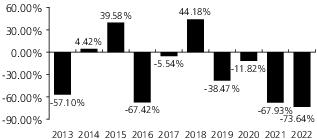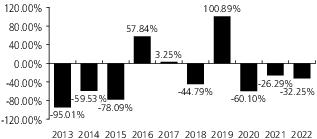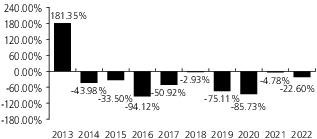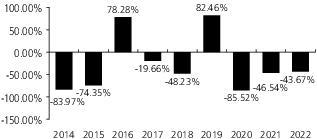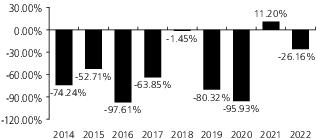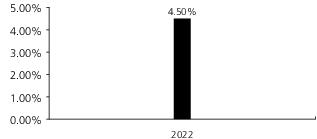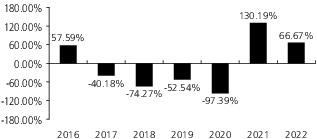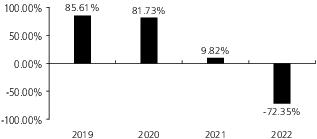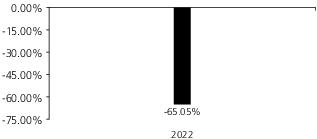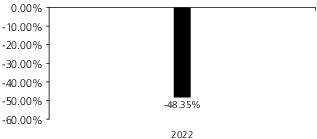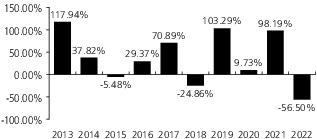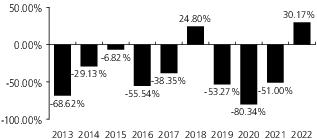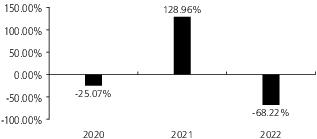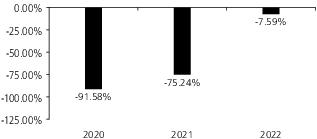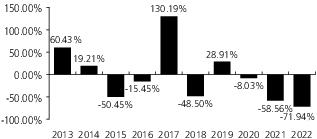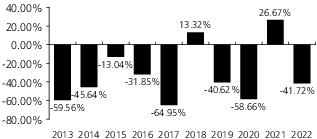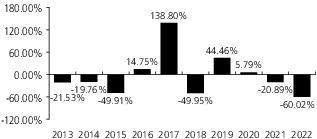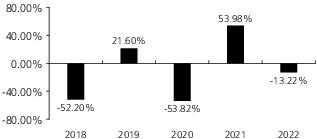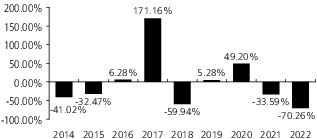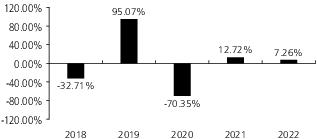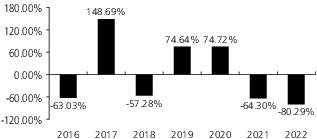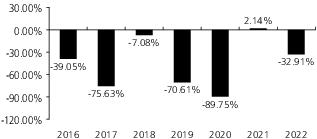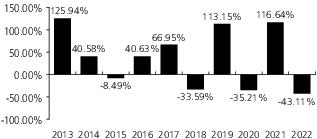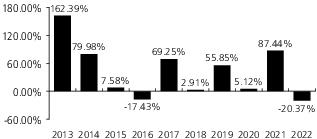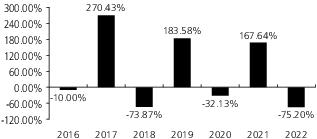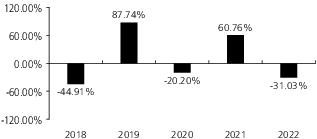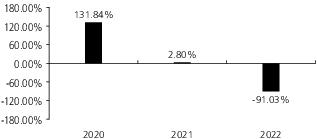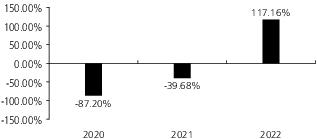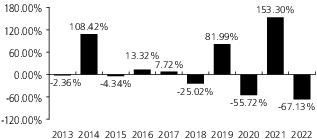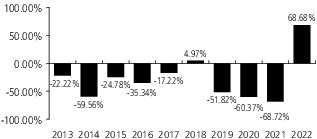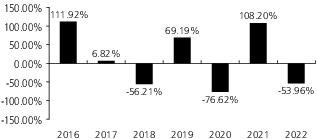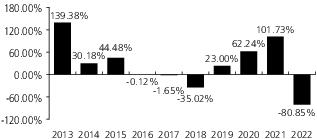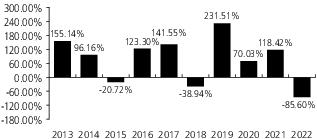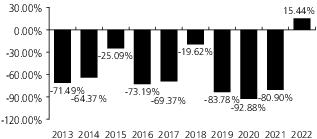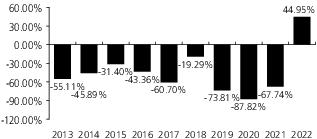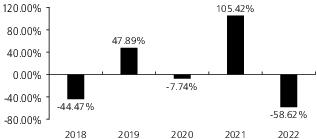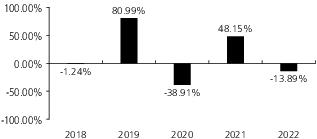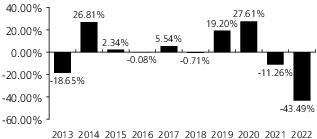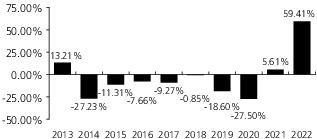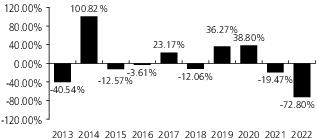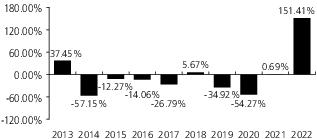
Direxion Shares ETF Trust
Prospectus
| 1301 Avenue of the Americas (6th Avenue), 28th Floor |
New York, New York 10019 |
(866) 476-7523 |
www.direxion.com
Direxion NASDAQ-100® Equal Weighted Index Shares (QQQE)
Direxion Work From Home ETF (WFH)
Direxion Moonshot Innovators ETF (MOON)
Direxion Hydrogen ETF (HJEN)
Direxion mRNA ETF (MSGR)
Direxion Electric and Autonomous Vehicles ETF (EVEH)
February 28, 2023
The shares offered in this prospectus (each a “Fund” and collectively the “Funds”) are, or upon commencement of operations will be, listed and traded on the NYSE Arca, Inc., except for the Direxion NASDAQ-100® Equal Weighted Index Shares, which is listed on Nasdaq.
There is no assurance that a Fund will achieve its investment objective and an investment in a Fund could lose money. No single Fund is a complete investment program.
These securities have not been approved or disapproved by the U.S. Securities and Exchange Commission (“SEC”) or the U.S. Commodity Futures Trading Commission (“CFTC”), nor have the SEC or CFTC passed upon the adequacy of this Prospectus. Any representation to the contrary is a criminal offense.
Summary Section
| Management Fees |
|
| Distribution and/or Service (12b-1) Fees |
|
| Other Expenses (Operating Services Fees)(1) |
|
| Total Annual Fund Operating Expenses |
|
(1)
| 1 Year |
3 Years |
5 Years |
10 Years |
| $ |
$ |
$ |
$ |
1
Direxion Shares ETF Trust Prospectus
Direxion Shares ETF Trust Prospectus
2
3
Direxion Shares ETF Trust Prospectus
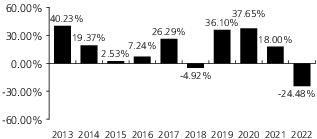
| |
1 Year |
5 Years |
10 Years |
| Return Before Taxes |
-24.48% |
9.68% |
13.95% |
| Return After Taxes on Distributions |
-24.65% |
9.21% |
13.57% |
| Return After Taxes on Distributions and Sale of Fund Shares |
-14.36% |
7.58% |
11.67% |
| NASDAQ-100® Equal Weighted Index (reflects no deduction for fees, expenses or taxes) |
-24.31% |
10.06% |
14.38% |
| NASDAQ-100® Index (reflects no deduction for fees, expenses or taxes) |
-32.38% |
12.36% |
16.45% |
| S&P 500® Index (reflects no deduction for fees, expenses or taxes) |
-18.11% |
9.42% |
12.56% |
Management
Investment Adviser. Rafferty Asset Management, LLC is the Fund’s investment adviser.
Portfolio Managers. The following members of Rafferty’s investment team are jointly and primarily responsible for the day-to-day management of the Fund:
Direxion Shares ETF Trust Prospectus
4
| Portfolio Managers |
Years of Service with the Fund |
Primary Title |
| Paul Brigandi |
Since Inception in March 2012 |
Portfolio Manager |
| Tony Ng |
Since September 2015 |
Portfolio Manager |
Purchase and Sale of Fund Shares
The Fund’s individual shares may only be purchased or sold in the secondary market through a broker-dealer or other financial intermediaries at market price rather than at net asset value. The market price of Shares will fluctuate in response to changes in the value of the Fund’s holdings and supply and demand for the Shares, which may result in shareholders purchasing or selling the Shares on the secondary market at a market price that is greater than net asset value (a premium) or less than net asset value (a discount). A shareholder may incur costs attributable to the difference between the highest price a buyer is willing to pay for the Fund’s Shares (bid) and the lowest price a seller is willing to accept for the Fund’s Shares (ask) when buying or selling Shares on the secondary market (the “bid-ask spread”) in addition to brokerage commissions. The bid-ask spread may vary over time for Shares based on trading volume and market liquidity. Recent information regarding the Fund Shares such as net asset value, market price, premiums and discounts and bid-ask spreads and related other information is available on the Fund’s website, www.direxion.com/etfs?producttab=performance.
The Fund’s shares are not individually redeemable by the Fund. The Fund will issue and redeem Shares only to Authorized Participants in exchange for cash or a deposit or delivery of a basket of assets (securities and/or cash) in large blocks, known as creation units, each of which is comprised of 50,000 Shares.
Tax Information
The Fund intends to make distributions that may be taxed as ordinary income or long-term capital gains. Those distributions will be subject to federal income tax and may also be subject to state and local taxes, unless you are investing through a tax-deferred arrangement, such as a 401(k) plan or an individual retirement account. Distributions or investments made through tax-deferred arrangements may be taxed later upon withdrawal. Distributions by the Fund may be significantly higher than those of most other ETFs.
Payments to Broker-Dealers and Other Financial Intermediaries
If you purchase shares of the Fund through a broker-dealer or other financial intermediary (such as a bank or financial advisor), the Fund and/or its Adviser may pay the intermediary for the sale of Fund shares and related services. These payments may create a conflict of interest by influencing the broker-dealer or other financial intermediary and your salesperson to recommend the Fund over another investment. Ask your salesperson or visit your financial intermediary’s website for more information.
Index Information
NASDAQ®, OMX®, NASDAQ OMX®, and NASDAQ-100 Equal WeightedSM Index are registered trademarks and certain trade names and service marks of The NASDAQ OMX Group, Inc. (which with its affiliates is referred to as the “Corporations”) and are licensed for use by Rafferty Asset Management, LLC. The Fund has not been passed on by the Corporations as to their legality or suitability. The Fund is not issued, endorsed, sold, or promoted by the Corporations. THE CORPORATIONS MAKE NO WARRANTIES AND BEAR NO LIABILITY WITH RESPECT TO THE PRODUCT(S).
5
Direxion Shares ETF Trust Prospectus
| Management Fees |
|
| Distribution and/or Service (12b-1) Fees |
|
| Other Expenses (Operating Services Fees)(1) |
|
| Total Annual Fund Operating Expenses |
|
(1)
| 1 Year |
3 Years |
5 Years |
10 Years |
| $ |
$ |
$ |
$ |
Direxion Shares ETF Trust Prospectus
6
7
Direxion Shares ETF Trust Prospectus
Direxion Shares ETF Trust Prospectus
8
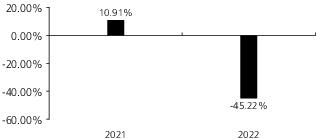
9
Direxion Shares ETF Trust Prospectus
| |
1 Year |
Since Inception 6/25/2020 |
| Return Before Taxes |
-45.22% |
-7.26% |
| Return After Taxes on Distributions |
-45.27% |
-7.50% |
| Return After Taxes on Distributions and Sale of Fund Shares |
-26.73% |
-5.44% |
| Solactive Remote Work Index (reflects no deduction for fees, expenses or taxes) |
-45.14% |
-7.13% |
| S&P 500® Index (reflects no deduction for fees, expenses or taxes) |
-18.11% |
11.27% |
Management
Investment Adviser. Rafferty Asset Management, LLC is the Fund’s investment adviser.
Portfolio Managers. The following members of Rafferty’s investment team are jointly and primarily responsible for the day-to-day management of the Fund:
| Portfolio Managers |
Years of Service with the Fund |
Primary Title |
| Paul Brigandi |
Since Inception in June 2020 |
Portfolio Manager |
| Tony Ng |
Since Inception in June 2020 |
Portfolio Manager |
Purchase and Sale of Fund Shares
The Fund’s individual shares may only be purchased or sold in the secondary market through a broker-dealer or other
financial intermediaries at market price rather than at net asset value. The market price of Shares will fluctuate in response to changes in the value of the Fund’s holdings and supply and demand for the Shares, which may result in shareholders purchasing or selling the Shares on the secondary market at a market price that is greater than net asset value (a premium) or less than net asset value (a discount). A shareholder may incur costs attributable to the difference between the highest price a buyer is willing to pay for the Fund’s Shares (bid) and the lowest price a seller is willing to accept for the Fund’s Shares (ask) when buying or selling Shares on the secondary market (the “bid-ask spread”) in addition to brokerage commissions. The bid-ask spread may vary over time for Shares based on trading volume and market liquidity. Recent information regarding the Fund Shares such as net asset value, market price, premiums and discounts and bid-ask spreads and related other information is available on the Fund’s website, www.direxion.com/etfs?producttab=performance.
The Fund’s shares are not individually redeemable by the Fund. The Fund will issue and redeem Shares only to Authorized Participants in exchange for cash or a deposit or delivery of a basket of assets (securities and/or cash) in large blocks, known as creation units, each of which is comprised of 25,000 Shares.
Tax Information
The Fund intends to make distributions that may be taxed as ordinary income or long-term capital gains. Those distributions will be subject to federal income tax and may also be subject to state and local taxes, unless you are investing through a tax-deferred arrangement, such as a 401(k) plan or an individual retirement account. Distributions or investments made through tax-deferred arrangements may be taxed later upon withdrawal. Distributions by the Fund may be significantly higher than those of most other ETFs.
Payments to Broker-Dealers and Other Financial Intermediaries
If you purchase shares of the Fund through a broker-dealer or other financial intermediary (such as a bank or financial adviser), the Fund and/or its Adviser may pay the intermediary for the sale of Fund shares and related services. These payments may create a conflict of interest by influencing the broker-dealer or other financial intermediary and your salesperson to recommend the Fund over another investment. Ask your salesperson or visit your financial intermediary’s website for more information.
Direxion Shares ETF Trust Prospectus
10
| Management Fees |
|
| Distribution and/or Service (12b-1) Fees |
|
| Other Expenses (Operating Services Fees)(1) |
|
| Total Annual Fund Operating Expenses |
|
(1)
| 1 Year |
3 Years |
5 Years |
10 Years |
| $ |
$ |
$ |
$ |
11
Direxion Shares ETF Trust Prospectus
Direxion Shares ETF Trust Prospectus
12
13
Direxion Shares ETF Trust Prospectus
Direxion Shares ETF Trust Prospectus
14
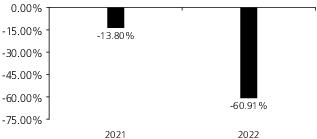
| |
1 Year |
Since Inception 11/12/2020 |
| Return Before Taxes |
-60.91% |
-32.81% |
| Return After Taxes on Distributions |
-60.91% |
-32.99% |
| Return After Taxes on Distributions and Sale of Fund Shares |
-36.06% |
-23.48% |
| S&P Kensho Moonshots Index (reflects no deduction for fees, expenses or taxes) |
-61.17% |
-33.28% |
| S&P 500® Index (reflects no deduction for fees, expenses or taxes) |
-18.11% |
5.04% |
Management
Investment Adviser. Rafferty Asset Management, LLC is the Fund’s investment adviser.
Portfolio Managers. The following members of Rafferty’s investment team are jointly and primarily responsible for the day-to-day management of the Fund:
| Portfolio Managers |
Years of Service with the Fund |
Primary Title |
| Paul Brigandi |
Since Inception in November 2020 |
Portfolio Manager |
| Tony Ng |
Since Inception in November 2020 |
Portfolio Manager |
Purchase and Sale of Fund Shares
The Fund’s individual shares may only be purchased or sold in the secondary market through a broker-dealer or other financial intermediaries at market price rather than at net asset value. The market price of Shares will fluctuate in response to changes in the value of the Fund’s holdings and supply and demand for the Shares, which may result in shareholders purchasing or selling the Shares on the secondary market at a market price that is greater than net asset value (a premium) or less than net asset value (a discount). A shareholder may incur costs attributable to the difference between the highest price a buyer is willing to pay for the Fund’s Shares (bid) and the lowest price a seller is willing to accept for the Fund’s Shares (ask) when buying or selling Shares on the secondary market (the “bid-ask spread”) in addition to brokerage commissions. The bid-ask spread may vary over time for Shares based on trading volume and market liquidity. Recent information regarding the Fund Shares such as net asset value, market price, premiums and
15
Direxion Shares ETF Trust Prospectus
discounts and bid-ask spreads and related other information is available on the Fund’s website, www.direxion.com/etfs?producttab=performance.
The Fund’s shares are not individually redeemable by the Fund. The Fund will issue and redeem Shares only to Authorized Participants in exchange for cash or a deposit or delivery of a basket of assets (securities and/or cash) in large blocks, known as creation units, each of which is comprised of 25,000 Shares.
Tax Information
The Fund intends to make distributions that may be taxed as ordinary income or long-term capital gains. Those distributions will be subject to federal income tax and may also be subject to state and local taxes, unless you are investing through a tax-deferred arrangement, such as a 401(k) plan or an individual retirement account. Distributions or investments made through tax-deferred arrangements may be taxed later upon withdrawal. Distributions by the Fund may be significantly higher than those of most other ETFs.
Payments to Broker-Dealers and Other Financial Intermediaries
If you purchase shares of the Fund through a broker-dealer or other financial intermediary (such as a bank or financial adviser), the Fund and/or its Adviser may pay the intermediary for the sale of Fund shares and related services. These payments may create a conflict of interest by influencing the broker-dealer or other financial intermediary and your salesperson to recommend the Fund over another investment. Ask your salesperson or visit your financial intermediary’s website for more information.
Index Information
The “S&P Kensho Moonshots Index ” is a product of S&P Dow Jones Indices LLC (“SPDJI”), and has been licensed for use by Rafferty. Standard & Poor’s® and S&P® are registered trademarks of Standard & Poor’s Financial Services LLC (“S&P”); Dow Jones® is a registered trademark of Dow Jones Trademark Holdings LLC (“Dow Jones”); and these trademarks have been licensed for use by SPDJI and sublicensed for certain purposes by Rafferty. The Fund is not sponsored, endorsed, sold or promoted by SPDJI, Dow Jones, S&P, or their respective affiliates and none of such parties make any representation regarding the advisability of investing in such product(s) nor do they have any liability for any errors, omissions, or interruptions of the S&P Kensho Moonshots Index .
Direxion Shares ETF Trust Prospectus
16
| Management Fees |
|
| Distribution and/or Service (12b-1) Fees |
|
| Other Expenses (Operating Services Fees)(1) |
|
| Total Annual Fund Operating Expenses |
|
(1)
| 1 Year |
3 Years |
5 Years |
10 Years |
| $ |
$ |
$ |
$ |
17
Direxion Shares ETF Trust Prospectus
Direxion Shares ETF Trust Prospectus
18
19
Direxion Shares ETF Trust Prospectus
Direxion Shares ETF Trust Prospectus
20
21
Direxion Shares ETF Trust Prospectus
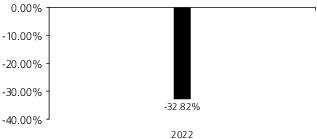
| |
1 Year |
Since Inception 3/25/2021 |
| Return Before Taxes |
-32.82% |
-28.27% |
| Return After Taxes on Distributions |
-33.03% |
-28.47% |
| Return After Taxes on Distributions and Sale of Fund Shares |
-19.32% |
-20.82% |
| Indxx Hydrogen Economy Index (reflects no deduction for fees, expenses or taxes) |
-33.09% |
-26.12% |
| S&P 500® Index (reflects no deduction for fees, expenses or taxes) |
-18.11% |
0.80% |
Management
Investment Adviser. Rafferty Asset Management, LLC is the Fund’s investment adviser.
Portfolio Managers. The following members of Rafferty’s investment team are jointly and primarily responsible for the day-to-day management of the Fund:
| Portfolio Managers |
Years of Service with the Fund |
Primary Title |
| Paul Brigandi |
Since Inception in March 2021 |
Portfolio Manager |
| Tony Ng |
Since Inception in March 2021 |
Portfolio Manager |
Purchase and Sale of Fund Shares
The Fund’s individual shares may only be purchased or sold in the secondary market through a broker-dealer or other financial intermediaries at market price rather than at net asset value. The market price of Shares will fluctuate in response to changes in the value of the Fund’s holdings and supply and demand for the Shares, which may result in shareholders purchasing or selling the Shares on the secondary market at a market price that is greater than net asset value (a premium) or less than net asset value (a discount). A shareholder may incur costs attributable to the difference between the highest price a buyer is willing to pay for the Fund’s Shares (bid) and the lowest price a seller is willing to accept for the Fund’s Shares (ask) when buying or selling Shares on the secondary market (the “bid-ask spread”) in addition to brokerage commissions. The bid-ask spread may vary over time for Shares based on trading volume and market liquidity. Recent information regarding the Fund Shares such as net asset value, market price, premiums and discounts and bid-ask spreads and related other information
Direxion Shares ETF Trust Prospectus
22
is available on the Fund’s website, www.direxion.com/etfs?producttab=performance.
The Fund’s shares are not individually redeemable by the Fund. The Fund will issue and redeem Shares only to Authorized Participants in exchange for cash or a deposit or delivery of a basket of assets (securities and/or cash) in large blocks, known as creation units, each of which is comprised of 50,000 Shares.
Tax Information
The Fund intends to make distributions that may be taxed as ordinary income or long-term capital gains. Those distributions will be subject to federal income tax and may also be subject to state and local taxes, unless you are investing through a tax-deferred arrangement, such as a 401(k) plan or an individual retirement account. Distributions or investments made through tax-deferred arrangements may be taxed later upon withdrawal. Distributions by the Fund may be significantly higher than those of most other ETFs.
Payments to Broker-Dealers and Other Financial Intermediaries
If you purchase shares of the Fund through a broker-dealer or other financial intermediary (such as a bank or financial adviser), the Fund and/or its Adviser may pay the intermediary for the sale of Fund shares and related services. These payments may create a conflict of interest by influencing the broker-dealer or other financial intermediary and your salesperson to recommend the Fund over another investment. Ask your salesperson or visit your financial intermediary’s website for more information.
23
Direxion Shares ETF Trust Prospectus
| Management Fees |
|
| Distribution and/or Service (12b-1) Fees |
|
| Other Expenses (Operating Services Fees)(1) |
|
| Total Annual Fund Operating Expenses |
|
(1)
| 1 Year |
3 Years |
5 Years |
10 Years |
| $ |
$ |
$ |
$ |
Direxion Shares ETF Trust Prospectus
24
25
Direxion Shares ETF Trust Prospectus
Direxion Shares ETF Trust Prospectus
26
27
Direxion Shares ETF Trust Prospectus
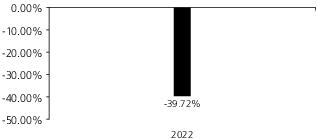
| |
1 Year |
Since Inception 12/9/2021 |
| Return Before Taxes |
-39.72% |
-41.07% |
| Return After Taxes on Distributions |
-39.72% |
-41.07% |
| Return After Taxes on Distributions and Sale of Fund Shares |
-23.51% |
-31.17% |
| BITA Messenger RNA Technology Index (reflects no deduction for fees, expenses or taxes) |
-39.54% |
-40.89% |
| S&P 500® Index (reflects no deduction for fees, expenses or taxes) |
-18.11% |
-16.00% |
Management
Investment Adviser. Rafferty Asset Management, LLC is the Fund’s investment adviser.
Portfolio Managers. The following members of Rafferty’s investment team are jointly and primarily responsible for the day-to-day management of the Fund:
| Portfolio Managers |
Years of Service with the Fund |
Primary Title |
| Paul Brigandi |
Since Inception in December 2021 |
Portfolio Manager |
| Tony Ng |
Since Inception in December 2021 |
Portfolio Manager |
Purchase and Sale of Fund Shares
The Fund’s individual shares may only be purchased or sold in the secondary market through a broker-dealer or other financial intermediaries at market price rather than at net
Direxion Shares ETF Trust Prospectus
28
asset value. The market price of Shares will fluctuate in response to changes in the value of the Fund’s holdings and supply and demand for the Shares, which may result in shareholders purchasing or selling the Shares on the secondary market at a market price that is greater than net asset value (a premium) or less than net asset value (a discount). A shareholder may incur costs attributable to the difference between the highest price a buyer is willing to pay for the Fund’s Shares (bid) and the lowest price a seller is willing to accept for the Fund’s Shares (ask) when buying or selling Shares on the secondary market (the “bid-ask spread”) in addition to brokerage commissions. The bid-ask spread may vary over time for Shares based on trading volume and market liquidity. Recent information regarding the Fund Shares such as net asset value, market price, premiums and discounts and bid-ask spreads and related other information is available on the Fund’s website, www.direxion.com/etfs?producttab=performance.
The Fund’s shares are not individually redeemable by the Fund. The Fund will issue and redeem Shares only to Authorized Participants in exchange for cash or a deposit or delivery of a basket of assets (securities and/or cash) in large blocks, known as creation units, each of which is comprised of 25,000 Shares.
Tax Information
The Fund intends to make distributions that may be taxed as ordinary income or long-term capital gains. Those distributions will be subject to federal income tax and may also be subject to state and local taxes, unless you are investing through a tax-deferred arrangement, such as a 401(k) plan or an individual retirement account. Distributions or investments made through tax-deferred arrangements may be taxed later upon withdrawal. Distributions by the Fund may be significantly higher than those of most other ETFs.
Payments to Broker-Dealers and Other Financial Intermediaries
If you purchase shares of the Fund through a broker-dealer or other financial intermediary (such as a bank or financial adviser), the Fund and/or its Adviser may pay the intermediary for the sale of Fund shares and related services. These payments may create a conflict of interest by influencing the broker-dealer or other financial intermediary and your salesperson to recommend the Fund over another investment. Ask your salesperson or visit your financial intermediary’s website for more information.
29
Direxion Shares ETF Trust Prospectus
| Management Fees |
|
| Distribution and/or Service (12b-1) Fees |
|
| Other Expenses (Operating Services Fees)(1),(2) |
|
| Total Annual Fund Operating Expenses |
|
(1)
(2)
| 1 Year |
3 Years |
| $ |
$ |
Direxion Shares ETF Trust Prospectus
30
31
Direxion Shares ETF Trust Prospectus
Direxion Shares ETF Trust Prospectus
32
33
Direxion Shares ETF Trust Prospectus
Management
Investment Adviser. Rafferty Asset Management, LLC is the Fund’s investment adviser.
Portfolio Managers. The following members of Rafferty’s investment team are jointly and primarily responsible for the day-to-day management of the Fund:
| Portfolio Managers |
Years of Service with the Fund |
Primary Title |
| Paul Brigandi |
Since Inception |
Portfolio Manager |
| Tony Ng |
Since Inception |
Portfolio Manager |
Purchase and Sale of Fund Shares
The Fund’s individual shares may only be purchased or sold in the secondary market through a broker-dealer or other financial intermediaries at market price rather than at net asset value. The market price of Shares will fluctuate in response to changes in the value of the Fund’s holdings and supply and demand for the Shares, which may result in shareholders purchasing or selling the Shares on the secondary market at a market price that is greater than net asset value (a premium) or less than net asset value (a
discount). A shareholder may incur costs attributable to the difference between the highest price a buyer is willing to pay for the Fund’s Shares (bid) and the lowest price a seller is willing to accept for the Fund’s Shares (ask) when buying or selling Shares on the secondary market (the “bid-ask spread”) in addition to brokerage commissions. The bid-ask spread may vary over time for Shares based on trading volume and market liquidity. Recent information regarding the Fund Shares such as net asset value, market price, premiums and discounts and bid-ask spreads and related other information is available on the Fund’s website, www.direxion.com/etfs?producttab=performance.
The Fund’s shares are not individually redeemable by the Fund. The Fund will issue and redeem Shares only to Authorized Participants in exchange for cash or a deposit or delivery of a basket of assets (securities and/or cash) in large blocks, known as creation units, each of which is comprised of 25,000 Shares.
Tax Information
The Fund intends to make distributions that may be taxed as ordinary income or long-term capital gains. Those distributions will be subject to federal income tax and may also be subject to state and local taxes, unless you are investing through a tax-deferred arrangement, such as a 401(k) plan or an individual retirement account. Distributions or investments made through tax-deferred arrangements may be taxed later upon withdrawal. Distributions by the Fund may be significantly higher than those of most other ETFs.
Payments to Broker-Dealers and Other Financial Intermediaries
If you purchase shares of the Fund through a broker-dealer or other financial intermediary (such as a bank or financial adviser), the Fund and/or its Adviser may pay the intermediary for the sale of Fund shares and related services. These payments may create a conflict of interest by influencing the broker-dealer or other financial intermediary and your salesperson to recommend the Fund over another investment. Ask your salesperson or visit your financial intermediary’s website for more information.
Direxion Shares ETF Trust Prospectus
34
Overview of the Funds
The Direxion Shares ETF Trust (the “Trust”) is a registered investment company offering a number of separate exchange-traded funds (“ETFs”). This Prospectus describes the ETFs noted in the table below (each, a “Fund” and collectively, the “Funds”). Rafferty Asset Management, LLC serves as the investment advisor to the Funds ("Rafferty" or the "Adviser").
Each Fund, under normal circumstances, invests at least 80% of its net assets (plus any borrowings for investment purposes) in the securities of its underlying index or investments with economic characteristics similar to the securities included in its underlying index as noted below:
| Fund |
Underlying Index |
| Direxion NASDAQ-100® Equal Weighted Index Shares |
NASDAQ-100® Equal Weighted Index |
| Direxion Work From Home ETF |
Solactive Remote Work Index |
| Direxion Moonshot Innovators ETF |
S&P Kensho Moonshots Index |
| Direxion Hydrogen ETF |
Indxx Hydrogen Economy Index |
| Direxion mRNA ETF |
BITA Messenger RNA Technology Index |
| Direxion Electric and Autonomous Vehicles ETF |
Indxx US Electric and Autonomous Vehicles Index |
Shares of the Funds (“Shares”) are, or upon commencement of operations will be, listed and traded on NYSE Arca, except for the Direxion NASDAQ-100® Equal Weighted Index Shares, which is listed on the Nasdaq Stock Market LLC (each an “Exchange”), where the market prices for the Shares may be different from the intra-day value of the Shares disseminated by the Exchange and from their net asset value (“NAV”). Unlike conventional mutual funds, Shares are not individually redeemable directly with a Fund. Rather, each Fund issues and redeems Shares on a continuous basis at NAV only in large blocks of Shares called “Creation Units.” A Creation Unit consists of 50,000 for the Direxion NASDAQ-100® Equal Weighted Index Shares and Direxion Hydrogen ETF and 25,000 for the remainder of the Funds Shares. As a result, retail investors generally will not be able to purchase or redeem Shares directly from, or with, each Fund. Most retail investors will purchase or sell Shares in the secondary market through a broker.
There is no assurance that each Fund will achieve its investment objective and an investment in a Fund could lose money. No single Fund is a complete investment program.
Changes in Investment Objective. Each Fund’s investment objective is not a fundamental policy and may be changed by the Funds' Board of Trustees without shareholder approval.
Additional Information Regarding Investment Techniques and Policies
Rafferty uses a number of investment techniques in an effort to achieve the stated investment objective for each Fund. To do this, Rafferty uses statistical and quantitative analysis to determine the investments a Fund makes and the techniques it employs. In general, if a Fund is performing as designed, the return of the underlying index will dictate the return for the Fund. Rafferty does not invest the assets of a Fund in securities, derivatives or other investments based on Rafferty’s view of the investment merit of a particular security, instrument or company, nor does it conduct conventional investment research or analysis or forecast market movements or trends. Each Fund pursues its investment objective regardless of market conditions and does not generally take defensive positions. If a Fund takes a temporary defensive position, it may not meet its investment objective during such periods.
35
Direxion Shares ETF Trust Prospectus
Additional Information Regarding Principal Risks
An investment in a Fund entails risks. A Fund may not achieve its investment objective and may decline in value. It is important that investors closely review and understand all of a Fund’s risks before making an investment. A Fund is not a complete investment program. Risks of investing in the Funds are described below.
| |
|
|
|
|
|
|
| |
Direxion NASDAQ-100® Equal Weighted Index Shares |
Direxion Work From Home ETF |
Direxion Moonshot Innovators ETF |
Direxion Hydrogen ETF |
Direxion mRNA ETF |
Direxion Electric and Autonomous Vehicle ETF |
| Alternative Energy Industry Risk |
|
|
|
X |
|
|
| Electric and Autonomous Vehicles Company Risk |
|
|
|
|
|
X |
| Hydrogen Company Risk |
|
|
|
X |
|
|
| Innovative Technologies Risk |
|
|
X |
|
|
|
| mRNA Technologies Risk |
|
|
|
|
X |
|
| Index Correlation Risk |
X |
X |
X |
X |
X |
X |
| Index Strategy Risk |
X |
X |
X |
X |
X |
X |
| Security Volatility Risk |
|
|
X |
|
|
|
| Biotechnology Industry Risk |
|
|
|
|
X |
|
| Consumer Discretionary Sector Risk |
X |
|
|
|
|
X |
| Energy Sector Risk |
|
|
|
X |
|
|
| Healthcare Sector Risk |
|
|
X |
|
X |
|
| Industrials Sector Risk |
|
|
X |
X |
|
X |
| Information Technology Sector Risk |
X |
X |
X |
|
|
X |
| Materials Sector Risk |
|
|
|
X |
|
|
| American Depositary Receipts |
|
X |
|
|
|
|
| Passive Investment Risk |
X |
X |
X |
X |
X |
X |
| Market Risk |
X |
X |
X |
X |
X |
X |
| Micro-Capitalization Company Risk |
|
X |
X |
X |
X |
|
| Small- and/or Mid-Capitalization Company Risk |
|
X |
X |
X |
X |
X |
| Large-Capitalization Company Risk |
X |
X |
X |
X |
X |
X |
| Japanese Securities Risk |
|
|
|
X |
|
|
| Currency Exchange Rate Risk |
|
|
|
X |
X |
|
| Depositary Receipt Risk |
X |
|
|
X |
X |
|
| Foreign Securities Risk |
X |
X |
|
X |
X |
|
| International Closed-Market Trading Risk |
|
|
|
X |
X |
|
| Natural Language Processing Risk |
|
X |
X |
|
|
|
| Liquidity Risk |
X |
X |
X |
X |
X |
X |
| Early Close/Trading Halt Risk |
X |
X |
X |
X |
X |
X |
| Equity Securities Risk |
X |
X |
X |
X |
X |
X |
| High Portfolio Turnover Risk |
|
|
X |
|
|
X |
| Cash Transaction Risk |
X |
X |
X |
X |
X |
X |
| Tax Risk |
X |
X |
X |
X |
X |
X |
| Non-Diversification Risk |
X |
X |
X |
X |
X |
X |
| Securities Lending Risk |
X |
X |
X |
X |
X |
X |
| Special Risks of Exchange-Traded Funds |
X |
X |
X |
X |
X |
X |
Direxion Shares ETF Trust Prospectus
36
Alternative Energy Industry Risk
Alternative energy refers to the generation of power through environmentally friendly sources that can replace or supplement traditional fossil-fuel sources. Companies in the alternative energy industry may be significantly impacted by obsolescence of existing technology, short product cycles, falling prices and profits, competition from new market entrants and general economic conditions. In addition, intense competition and legislation resulting in more strict government regulations and enforcement policies and specific expenditures for cleanup efforts can affect the industry. Risks associated with hazardous materials, fluctuation in energy prices and supply and demand of alternative energy fuels, energy conservation, the success of exploration projects and tax incentives and subsidies and other government regulations can significantly impact this industry. Also, supply of, and demand for, specific products or services, the supply of, and demand for, oil and gas, the prices of oil and gas, production spending, government regulation, world events, and economic conditions may affect the industry. Companies in this industry may be adversely affected by commodity price volatility, changes in exchange rates, imposition of import controls, availability of certain inputs and materials required for production, depletion of resources, technological developments, and labor relations. Recently, the price of oil has declined significantly and experienced significant volatility, which may have a material adverse impact on companies operating in the alternative energy sector.
Alternative energy companies may be highly dependent on government policies that support alternative or clean energy policies and enhance the economic viability of these industries. Adverse weather conditions may cause fluctuations in the production of alternative energy. These companies are also heavily dependent on intellectual property rights and may be adversely affected by loss or impairment of those rights. Shares of companies involved in the alternative energy industry have been more volatile than shares of companies operating in more established industries. Furthermore, these companies may have a limited operating history and may never have operated profitably. Investment in young companies with a short operating history is generally riskier than investing in companies with a longer operating history. A Fund may have greater risk and be more volatile than a portfolio composed of securities issued by companies operating in a wide variety of different, or more established, industries.
Electric and Autonomous Vehicles Company Risk
Electric and autonomous vehicles companies typically face intense competition and potentially rapid product obsolescence. Many of these companies are also heavily dependent on intellectual property rights and may be adversely affected by loss or impairment of those rights. There can be no assurance these companies will be able to successfully protect their intellectual property to prevent the misappropriation of their technology, or that competitors will not develop technology that is substantially similar or superior to such companies’ technology. Electric and autonomous vehicles companies typically engage in significant amounts of spending on research and development, capital expenditures and mergers and acquisitions, and there is
no guarantee that the products or services produced by these companies will be successful. Companies that produce the raw materials that are used in electric vehicles may be concentrated in certain commodities, and therefore be exposed to the price fluctuations of those commodities. In addition, autonomous vehicle technology could face increasing regulatory scrutiny in the future, which may limit the development of this technology and impede the growth of companies that develop and/or utilize this technology. Electric and autonomous vehicles companies are also potential targets for cyberattacks, which can have a materially adverse impact on the performance of these companies. Electric and autonomous vehicles companies rely on artificial intelligence and big data technologies for the development of their platforms and, as a result, could face increased scrutiny as regulators consider how the data is collected, stored, safeguarded and used. The customers and/or suppliers of electric and autonomous vehicles companies may be concentrated in a particular country, region or industry, including in emerging markets. Any adverse event affecting one of these countries, regions or industries could have a negative impact on electric and autonomous vehicles companies.
Hydrogen Company Risk
Hydrogen companies may depend largely on the availability of hydrogen gas, certain third-party key suppliers for product components and a small number of customers may comprise a significant portion of their business. Hydrogen and fuel cell companies may be significantly impacted by obsolescence of existing technology, short product cycles, falling prices and profits, competition from new market entrants and general economic conditions. In addition, intense competition and legislation resulting in more strict government regulations and enforcement policies and specific expenditures for cleanup efforts can affect the industry. Because this is an emerging industry, companies are generally smaller and the share price of hydrogen companies may be more volatile than companies operating in other, more established industries.
Innovative Technologies Risk
Technologies perceived to displace older technologies or create new markets may not in fact do so. Companies that initially develop an innovative technology may not be able to capitalize on the technology. Companies that develop innovative technologies may face political or legal attacks from competitors, industry groups, or local and national governments. A Fund may invest in a company that does not currently derive any revenue from innovative technologies, and there is no assurance that a company will derive any revenue from innovative technologies in the future. An innovative technology may constitute a small portion of a company’s overall business. As a result, the success of an innovative technology may not affect the value of the equity securities issued by the company.
mRNA Technologies Risk
Messenger RNA (“mRNA”) technology, which is the basis for certain COVID-19 vaccines, is a novel technology, and the development of products or therapies based on mRNA
37
Direxion Shares ETF Trust Prospectus
technology has substantial clinical development and regulatory risks. A company utilizing mRNA technology may encounter difficulties manufacturing, producing, shipping or successfully commercializing its product. Certain mRNA-based vaccines only have received Emergency Use Authorization from the U.S. Food and Drug Administration and other provisional, interim or conditional authorizations from regulatory authorities outside the United States, and there is no guarantee that such vaccines will receive full approval in the future. Any delays in or failure to obtain approval may materially impact such companies. mRNA technologies may also prove ineffective or may produce adverse effects. For example, current COVID-19 vaccines developed from mRNA technologies may prove ineffective at providing protection against infection by variant strains of the SARS-CoV-2 virus, and a company may be unsuccessful in adapting its COVID-19 vaccine to protect effectively against variant strains of the SARS-CoV-2 virus. Additionally, mRNA technology-based medicines are a novel approach, and negative perception of the efficacy, safety, or tolerability of such medicines could adversely affect a company and the general acceptance of mRNA technologies.
Index Correlation Risk
There is no guarantee that a Fund will achieve a high degree of correlation to its underlying index and therefore achieve its investment objective. A Fund may have difficulty achieving its investment objective for many reasons, including fees, expenses (including rebalancing expenses), transaction costs, a Fund’s, valuation methodology differing from the its underlying index’s valuation methodology, accounting standards and their application to income items, required compliance with a Fund’s Exchange listing standards, disruptions or illiquidity in the markets for the securities held by a Fund, a Fund’s holding of uninvested cash, costs of complying with various new or existing regulatory requirements and tax considerations, which may cause a Fund to hold (or not hold) certain underlying index constituents. Activities surrounding index reconstitutions and other index rebalancing events may hinder a Fund’s ability to meet its investment objective. A Fund may not have investment exposure to all of the constituents of the its underlying index or its weighting of investment exposure to the constituents may be different from that of its underlying index, which may reduce a Fund’s correlation to its underlying index.
In addition, a Fund may invest in securities that are not included in its underlying index. A Fund may also invest directly in or use other investment companies, such as ETFs to pursue its investment objective. An ETF’s performance may differ from the index it tracks, thus resulting in additional tracking error for a Fund. Any of these factors could decrease correlation between the performance of a Fund and its underlying index and may hinder a Fund’s ability to meet its investment objective.
Index Strategy Risk
A Fund is linked to an underlying index maintained by a third party provider unaffiliated with a Fund (“Index Provider”) that exercises complete control over the the underlying index. An Index Provider may delay or change
a rebalance date, which may adversely impact the performance of a Fund and its correlation to the its underlying index. In addition, there is no guarantee that the methodology used by an Index Provider to identify constituents for an underlying index will achieve its intended result or positive performance. A Fund’s underlying index relies on various sources of information to assess the potential constituents of the its underlying index, including information that may be based upon assumptions or estimates. There is no assurance that the sources of information are reliable, and the Adviser does not assess the due diligence conducted by an Index Provider with respect to the data it uses or the its underlying index’s construction and computation processes. There is a heightened risk of unreliable and/or inaccurate data for an underlying index that includes issuers in foreign markets, especially emerging and frontier markets, where the markets and issuers may be subject to less stringent regulation and accounting requirements. An index may underperform other asset classes or similar indices. Errors in underlying index data, underlying index computations or the construction of the underlying index in accordance with its methodology may occur from time to time and may not be identified and/or corrected for a period of time or at all. Such differences may negatively or positively impact a Fund.
Unusual market conditions may cause an Index Provider to postpone a scheduled rebalance of the underlying index, which could adversely impact its normal or expected composition and performance. For example, if a rebalance is postponed in a time of market volatility, constituents that would otherwise be removed at the rebalance, including due to changes in market capitalizations, issuer credit ratings, or other reasons may remain and adversely impact a Fund’s performance. Similarly, an Index Provider may carry out an ad hoc rebalance of the underlying index at any time, which may adversely impact Fund performance.
Security Volatility Risk
Significant short-term price movements in the components and market sectors that make up a Fund’s underlying index could adversely impact the performance of both the underlying index and the Fund, increase the Fund’s bid-ask spread and adversely impact the Fund’s ability to achieve its investment objective. In addition, the NAV of a Fund over short-term periods may be more volatile than other investment options due the volatility of the underlying securities of the underlying index.
Biotechnology Industry Risk
Companies within the biotechnology industry invest heavily in research and development, which may not lead to commercially successful services or products or may become obsolete quickly. The biotechnology industry is also subject to significant governmental regulation and changes to governmental policies or the need for regulatory approvals, may delay or inhibit the release of new products. Many biotechnology companies are dependent upon their ability to use and enforce intellectual property rights and patents. Any impairment or expiration of such rights may have adverse financial consequences for these companies. Biotechnology stocks, especially those of smaller, less-seasoned companies, tend to be more volatile than the overall market.
Direxion Shares ETF Trust Prospectus
38
Biotechnology companies can be significantly affected by technological change and obsolescence, product liability lawsuits and consequential high insurance costs.
Consumer Discretionary Sector Risk
Because companies in the consumer discretionary sector manufacture products and provide discretionary services directly to the consumer, the success of these companies is tied closely to the performance of the overall domestic and international economy, including the functioning of the global supply chain, interest rates, competition and consumer confidence. Success depends heavily on disposable household income and consumer spending, and may be strongly affected by social trends and marketing campaigns. Also, companies in the consumer discretionary sector may be subject to severe competition, which may have an adverse impact on a company’s profitability. Changes in demographics and consumer tastes also can affect the demand for, and success of, consumer discretionary products in the marketplace.
Energy Sector Risk
The energy markets have experienced significant volatility recently due to Russia’s invasion of Ukraine in February 2022, and the resulting sanctions on Russia and other responses by the U.S and other countries. The effect of the U.S. sanctions and other similar sanctions by other countries, as well as the extent and duration of Russia’s military actions and the associated market disruptions on the energy sector are impossible to predict and depend on many factors. The effect of these events or any related developments could be significant and may have an adverse effect on the energy sector. Companies that engage in energy-related businesses may be cyclical and highly dependent on energy prices. Energy sector securities may be adversely impacted by the following factors, among others: changes in the levels and volatility of global energy prices, global supply and demand, and capital expenditures on the exploration and production of energy sources; exchange rates, interest rates, economic conditions, and tax treatment; and energy conservation efforts, increased competition and technological advances. Companies in this sector may be subject to substantial government regulation and contractual fixed pricing, which may increase the cost of doing business and limit earnings. A significant portion of an energy company’s revenue may come from a relatively small number of customers, including governmental entities and utilities. Energy companies may operate or engage in, transactions involving countries with less developed regulatory regimes or a history of expropriation, nationalization or other adverse policies. Energy companies may also be significantly impacted by the supply of, and demand for, specific products, such as oil and natural gas, and services, exploration and production spending, government subsidization, world events and general economic conditions. Energy companies may have relatively high levels of debt and may be more likely than other companies to restructure In addition, these companies are at risk of civil liability from accidents resulting in injury, loss of life or property, pollution or other environmental damage claims and risk of loss from terrorism, political unrest and natural disasters.
Healthcare Sector Risk
The profitability of companies in the healthcare sector may be affected by extensive, costly and uncertain government regulation, restrictions on government reimbursement for medical expenses, rising costs of medical products and services, pricing pressure, changes in the demand for medical products and services, an increased emphasis on outpatient services, limited product lines, industry innovation and/or consolidation, changes in technologies and other market developments. Many healthcare companies are heavily dependent on patent protection, which may be time consuming and costly. The expiration of patents may adversely affect the profitability of these companies. Many healthcare companies are subject to extensive litigation based on product liability and similar claims. In addition, their products can become obsolete due to industry innovation, changes in technologies or other market developments. Many new products in the health care sector require significant research and development and may be subject to regulatory approvals, all of which may be time consuming and costly with no guarantee that any product will come to market.
Industrials Sector Risk
Stock prices of issuers in the industrials sector are affected by supply and demand both for their specific product or service and for industrials sector products in general. Government regulation, world events, including trade disputes, exchange rates and economic conditions, technological developments and liabilities for environmental damage and general civil liabilities will also affect the performance of investment in such issuers. Aerospace and defense companies, a component of the industrials sector, can be significantly affected by government spending policies because companies involved in this industry rely to a significant extent on U.S. and other government demand for their products and services. Thus, the financial condition of, and investor interest in, aerospace and defense companies are heavily influenced by government defense spending policies which are typically under pressure from efforts to control government spending budgets. Transportation companies, another component of the industrials sector, are subject to cyclical performance and therefore investment in such companies may experience occasional sharp price movements which may result from changes in the economy, fuel prices, labor agreements and insurance costs. The industrials sector may also be adversely affected by changes or trends in commodity prices, which may be influenced by unpredictable factors. Issuers with high carbon intensity or high switching costs associated with the transition to low carbon alternatives may be more impacted by climate transition risks.
Information Technology Sector Risk
The value of stocks of information technology companies and companies that rely heavily on technology is particularly vulnerable to rapid changes in technology product cycles, rapid product obsolescence, government regulation, and competition, both domestically and internationally, including competition from competitors with lower production costs. In addition, many information technology companies have limited product lines, markets, financial resources or personnel. Information technology companies and companies that rely
39
Direxion Shares ETF Trust Prospectus
heavily on technology, especially those of smaller, less-seasoned companies, tend to be more volatile and less liquid than the overall market. Information technology companies are heavily dependent on patent and intellectual property rights, the loss or impairment of which may adversely affect profitability. Additionally, companies in the information technology sector may face dramatic and often unpredictable changes in growth rates and competition for the services of qualified personnel.
Materials Sector Risk
Companies in the materials sector could be adversely affected by commodity price volatility, exchange rate fluctuations, import controls and increased competition. The production of industrial materials often exceeds demand as a result of over-building or economic downturns, leading to poor investment returns. Companies in the materials sector also are at risk for environmental damage and product liability claims, and may be adversely affected by depletion of resources, technical progress, labor relations, political and social unrest, and governmental regulations.
American Depositary Receipts (“ADRs”) Risk
ADRs are an equity security issued by a U.S. bank or broker that represents one or more shares of a foreign-company stock held by the U.S. bank in the foreign company’s home stock market. ADRs may be listed on a major U.S. stock exchange or may be traded over the counter and are generally denominated in U.S. dollars. Because ADRs are issued by non-U.S. companies, they are subject to various foreign investment risks. These risks include the risk that the currency in the issuing company’s country will drop relative to the U.S. dollar, that politics or regime changes in the issuing company’s country will undermine exchange rates or destabilize the company and its earnings, or that inflation in the issuing company’s country will erode the value of the foreign currency. Additionally, investors may not have access to the same amount of information about the company that is available about domestic companies.
Passive Investment Risk
A Fund generally will not change its investment exposures, including by buying or selling securities or instruments, in response to market conditions. For example, a Fund generally will not buy or sell an underlying index’s constituents due to a change in its performance or based on changes to the prospects of an underlying index’s constituent, unless that constituent is removed from the underlying index with which a Fund seeks correlated performance.
Market Risk
A Fund’s investments are subject to changes in general economic conditions, general market fluctuations and the risks inherent in investment in securities markets. Investment markets can be volatile and prices of investments can change substantially due to various factors including, but not limited to, economic growth or recession, inflation rates and/or investor expectations concerning such rates, changes in interest rates, changes in the actual or perceived creditworthiness of issuers, general market liquidity, exchange trading suspensions and closures, and public health risks. Securities markets also may experience long periods of decline
in value. During a general downturn in the securities markets, multiple asset classes may decline in value simultaneously and changes in the financial condition of a single issuer can impact a market the markets broadly. A Fund is subject to the risk that geopolitical events will disrupt markets and adversely affect global economies, markets, and exchanges. Local, regional or global events such as war, acts of terrorism, natural disasters, the spread of infectious illness or other public health issues, conflicts and social unrest or other events could have a significant impact on a Fund, its investments and a Fund’s ability to achieve its investment objective.
To the extent that the instruments utilized by a Fund are thinly traded or have a limited market, a Fund may be unable to meet its investment objective due to a lack of available investments or counterparties. During such periods, a Fund’s ability to issue additional Creation Units may be adversely affected. As a result, a Fund’s shares could trade at a premium or discount to their NAV or the bid-ask spread of a Fund’s shares could widen. Under such circumstances, a Fund may increase its transaction fee, change its investment objective by, for example, seeking to track an alternative index, reduce its leverage or close. If a Fund must sell all or a portion of its investments, whether due to redemptions, a leverage reduction, its liquidation or otherwise, such sales may be at unfavorable prices and adversely affect a Fund.
Markets and market participants are increasingly reliant on information data systems. Inaccurate data, software or other technology malfunctions, programming inaccuracies, unauthorized use or access and similar circumstances may impair the performance of these systems and may have an adverse impact upon a single issuer, a group of issuers, or securities markets more broadly.
Micro-Capitalization Company Risk
Micro-capitalization companies often have limited product lines, narrower markets for their goods and/or services and more limited managerial and financial resources than larger, more established companies, including companies which are considered small- or mid-capitalization. In addition, because these stocks are not well known to the investing public, do not have significant institutional ownership and are followed by relatively few security analysts, there will normally be less publicly available information concerning these securities compared to what is available for the securities of larger companies. Adverse publicity and investor perceptions, whether based on fundamental analysis or rumor, can decrease the value and liquidity of such securities. As a result, their performance can be more volatile and they face greater risk of business failure.
Small- and/or Mid-Capitalization Company Risk
Small- and/or mid-capitalization companies often have narrower markets for their goods and/or services, less stable earnings, and more limited managerial and financial resources. Furthermore, those companies often have limited product lines, services, markets, financial resources or are dependent on a small management group. Because these stocks are not well-known to the investing public, there will normally be less publicly available information concerning these securities. Adverse publicity and investor perceptions, whether
Direxion Shares ETF Trust Prospectus
40
or not based on fundamental analysis, can decrease the value and liquidity of such securities, resulting in more volatile performance. They also face greater risk of business failure.
Large-Capitalization Company Risk
Large-capitalization companies typically have significant financial resources, extensive product lines and broad markets for their goods and/or services. However, they may be less able to adapt to changing market conditions or to respond quickly to competitive challenges or to changes in business, product, financial, or market conditions. Larger companies may not be able to maintain growth at rates that may be achieved by well-managed smaller and mid-size companies, which may affect the companies’ returns.
Japanese Securities Risk
The growth of Japan’s economy has lagged that of its Asian neighbors and other major developed countries. Since 2000, Japan’s economic growth rate has remained relatively low, and it may remain low in the future. The Japanese economy is characterized by government intervention and protectionism, an unstable financial services sector, changes in its labor market, and is heavily dependent on international trade and has been adversely affected by trade tariffs and competition from emerging economies. As such, economic growth is heavily dependent on continued growth in international trade, government support of the financial services sector, among other troubled sectors, and consistent government policy. Any changes or trends in these economic factors could have a significant impact on Japan’s economy overall and may negatively affect the Fund’s investment. Japan’s economy is also closely tied to its two largest trading partners, the U.S. and China. Economic volatility in either nation may create volatility in Japan’s economy as well. Additionally, Japan’s relations with its neighbors, particularly China, North Korea, South Korea and Russia, have at times been strained due to territorial disputes, historical animosities and defense concerns.
Currency Exchange Rate Risk
Changes in foreign currency exchange rates will affect the value of a Fund’s investments in securities denominated in a country’s currency. Generally, when the U.S. Dollar rises in value against a foreign currency, an investment in that country loses value because that currency is worth fewer U.S. Dollars. Devaluation of a currency by a country’s government or banking authority also will have a significant impact on the value of any investments denominated in that currency. If a Fund is exposed to a limited number of currencies, any change in the value of these currencies could have a material impact on a Fund’s NAV.
Depositary Receipt Risk
To the extent a Fund invests in, or has exposure to, foreign companies, investment may be in the form of depositary receipts or other securities convertible into securities of foreign issuers. American Depositary Receipts (“ADRs”) are receipts typically issued by an American bank or trust company that evidence ownership of underlying securities issued by a foreign corporation. European Depositary Receipts (“EDRs”) are receipts issued in Europe that evidence a similar ownership arrangement. Global Depositary Receipts (“GDRs”) are receipts
issued throughout the world that evidence a similar arrangement. Generally, ADRs, in registered form, are designed for use in the U.S. securities markets, and EDRs, in bearer form, are designed for use in European securities markets. GDRs are tradable both in the United States and in Europe and are designed for use throughout the world. Depositary receipts will not necessarily be denominated in the same currency as their underlying securities.
Depositary receipts may be purchased through “sponsored” or “unsponsored” facilities. A sponsored facility is established jointly by the issuer of the underlying security and a depositary, whereas a depositary may establish an unsponsored facility without participation by the issuer of the depositary security. Holders of unsponsored depositary receipts generally bear all the costs of such facilities and the depositary of an unsponsored facility frequently is under no obligation to distribute shareholder communications received from the issuer of the deposited security or to pass through voting rights to the holders of such receipts of the deposited securities.
Fund investments in depositary receipts, which include ADRs, GDRs and EDRs, are deemed to be investments in foreign securities for purposes of a Fund’s investment strategy.
Foreign Securities Risk
Foreign instruments may involve greater risks than domestic instruments. As a result, a Fund’s returns and NAV may be affected to a large degree by fluctuations in currency exchange rates, interest rates, political, diplomatic or economic conditions and regulatory requirements in other countries. The laws and accounting, auditing, and financial reporting standards in foreign countries typically are not as strict as they are in the United States, and there may be less public information available about foreign companies.
Foreign securities may involve additional risk, including, greater market volatility, the availability of less reliable financial information, higher transactional and custody costs, taxation by foreign governments, decreased market liquidity and political instability. Certain foreign markets may rely heavily on particular industries or foreign capital and are more vulnerable to diplomatic developments, the imposition of economic sanctions against a particular country or countries, organizations, entities and/or individuals, changes in international trade patterns, trade barriers, and other protectionists or retaliatory measures. Additionally, a Fund may be impacted by a limitation on foreign ownership of securities, the imposition of withholding or other taxes, restrictions on the repatriation of cash or other assets, higher transaction and custody costs, delays in the settlement of securities, difficulties in enforcing contractual obligations and lower levels of regulation in the securities markets.
International Closed-Market Trading Risk
Because a Fund may invest in, and/or have exposure to, securities that are traded in markets that are closed when the NYSE Arca, Inc. is open, and vice versa, there are likely to be deviations between its current value and its last sale price. As a result, premiums or discounts to NAV may develop in share prices. Additionally, the performance of a Fund may vary from the performance of its underlying index.
41
Direxion Shares ETF Trust Prospectus
Natural Language Processing Risk
The natural language processing classification system utilized by the Index is different than traditional classification systems because it utilizes automated natural language processing, such as key word searching, rather than backward looking metrics, such as a company’s past profits or revenue, to determine the classification of a company. The Index’s use of natural language processing may result in the Index including companies that may not be classified as nanotechnology companies by other classification systems.
Liquidity Risk
Some securities held by a Fund may be difficult to buy or sell or illiquid, particularly during times of market turmoil. Illiquid securities may be difficult to value, especially in changing or volatile markets. If a Fund is forced to buy or sell an illiquid security or derivative instrument at an unfavorable time or price, a Fund may incur a loss. Certain market conditions may prevent a Fund from limiting losses, realizing gains or achieving a high correlation with its underlying index. There is no assurance that a security or derivative instrument that is deemed liquid when purchased will continue to be liquid.
In certain cases, the market for certain securities in its underlying index and/or Fund may lack sufficient liquidity for all market participants' trades. Therefore, a Fund may have difficulty transacting in it and/or in correlated investments, such as swap contracts. Further, a Fund's transactions could exacerbate illiquidity and volatility in the price of the securities and correlated derivative instruments.
Early Close/Trading Halt Risk
An exchange or market may close or issue trading halts on specific securities or financial instruments, including shares of a Fund. Under such circumstances, the ability to buy or sell certain portfolio securities or financial instruments may be restricted, which may result in a Fund being unable to buy or sell investments for its portfolio, may disrupt a Fund’s creation/redemption process and may temporarily prevent investors from buying and selling shares of a Fund. In addition, a Fund may be unable to accurately price its investments, may fail to achieve performance that is correlated with its underlying index and may incur substantial losses.
Equity Securities Risk
Publicly-issued equity securities, including common stocks, are subject to market risks that may cause their prices to fluctuate over time. Fluctuations in the value of equity securities in which a Fund invests will cause the NAV of the Fund to fluctuate.
High Portfolio Turnover Risk
Engaging in active and frequent trading due to underlying index rebalances, cash purchases or sales of Fund shares, or other reasons leads to increased portfolio turnover, higher transaction costs, and the possibility of increased short-term capital gains (which will be taxable to shareholders as ordinary income when distributed to them) and/or long-term capital gains.
Cash Transaction Risk
At certain times, a Fund may effect creations and redemptions for cash rather than for in-kind securities. As a result, a Fund may not be tax efficient and may incur brokerage costs related to buying and selling securities to achieve its investment objective thus incurring additional expenses than if it had effected creations and redemptions in kind. To the extent that such costs are not offset by fees payable by an authorized participant, a Fund may bear such costs, which will decrease a Fund’s NAV.
Tax Risk
In order to qualify for the special tax treatment accorded a regulated investment company (“RIC”) and its shareholders, a Fund must derive at least 90% of its gross income for each taxable year from “qualifying income,” meet certain asset diversification tests at the end of each taxable quarter, and meet annual distribution requirements. A Fund’s pursuit of its investment strategy will potentially be limited by a Fund’s intention to qualify for such treatment and could adversely affect the Fund’s ability to so qualify. A Fund can make certain investments, the treatment of which for these purposes is unclear. If, in any year, a Fund were to fail to qualify for the special tax treatment accorded a RIC and its shareholders, and were ineligible to or were not to cure such failure, a Fund would be taxed in the same manner as an ordinary corporation subject to U.S. federal income tax on all its income at the fund level. The resulting taxes could substantially reduce a Fund’s net assets and the amount of income available for distribution. In addition, in order to requalify for taxation as a RIC, a Fund could be required to recognize unrealized gains, pay substantial taxes and interest, and make certain distributions. Please see the section entitled “Dividends, Other Distributions and Taxes” in the SAI for more information.
Non-Diversification Risk
Each Fund is classified as “non-diversified” under the Investment Company Act of 1940, as amended. This means it has the ability to invest a relatively high percentage of its assets in the securities of a small number of issuers or in financial instruments with a single counterparty or a few counterparties. This may increase a Fund’s volatility and increase the risk that a Fund’s performance will decline based on the performance of a single issuer or the credit of a single counterparty and make a Fund more susceptible to risks associated with a single economic, political or regulatory occurrence than a diversified fund.
Securities Lending Risk
Securities lending involves the risk that a Fund may lose money because the borrower of the loaned securities fails to return the securities in a timely manner or at all. A Fund could also lose money in the event of a decline in the value of collateral provided for loaned securities, a decline in the value of any investments made with cash collateral, or a “gap” between the return on cash collateral reinvestments and any fees a Fund has agreed to pay a borrower. These events could also trigger adverse tax consequences for a
Direxion Shares ETF Trust Prospectus
42
Fund. In the event of a large redemption while a Fund has loaned portfolio securities, a Fund may suffer losses (e.g. overdraft fees) if it is unable to recall the securities on loan in time to fulfill the redemption. There is also a risk that a Fund may not be able to recall loaned securities in sufficient time to vote on material proxy matters.
Special Risks of Exchange-Traded Funds
Authorized Participants Concentration Risk. A Fund may have a limited number of financial institutions that may act as Authorized Participants. To the extent that those Authorized Participants exit the business or are unable to process creation and/or redemption orders, Shares may trade at larger bid-ask spreads and/or premiums or discounts to NAV. Authorized Participant concentration risk may be heightened for a fund that invests in non-U.S. securities or other securities or instruments that have lower trading volumes.
Absence of Active Market Risk. Although Shares are listed for trading on a stock exchange, there is no assurance that an active trading market for them will develop or be maintained. In the absence of an active trading market for Shares, they will likely trade with a wider bid/ask spread and at a greater premium or discount to NAV.
Market Price Variance Risk. Shares of a Fund can be bought and sold in the secondary market at market prices rather than at NAV. When Shares trade at a price greater than NAV, they are said to trade at a “premium.” When they trade at a price less than NAV, they are said to trade at a “discount.” The market price of Shares fluctuates based on changes in the value of a Fund’s holdings and on the supply and demand for Shares. Because Shares can be created and redeemed in Creation Units at NAV, the Adviser believes that large discounts or premiums to the net asset value of Shares should not be sustained over the long term. Nevertheless, the market price of Shares may vary significantly from NAV during periods of market volatility. Further, to the extent that exchange specialists, market makers and/or Authorized Participants are unavailable or unable to trade a Fund’s Shares and/or create and redeem Creation Units, bid/ask spreads and premiums or discounts may widen. The exact exposure of an investment in a Fund intraday in the secondary market is a function of the difference between the value of the underlying index at the market close on the first trading day and the value of the underlying index at the time of purchase.
Trading Cost Risk. Buying or selling Fund shares on an exchange involves two types of costs that apply to all securities transactions. When buying or selling shares of a Fund through a broker, you will likely incur a brokerage commission and other charges. In addition, you may incur the cost of the “spread”; that is, the difference between what investors are willing to pay for Fund shares (the “bid” price) and the price at which they are willing to sell Fund shares (the “ask” price). The spread, which varies over time for shares of a Fund based on trading volume and market liquidity, is generally narrower if the Fund has more trading volume and market liquidity and wider if the Fund has less trading volume and market liquidity. In addition, increased market
volatility may cause wider spreads. There may also be regulatory and other charges that are incurred as a result of trading activity. Because of the costs inherent in buying or selling Fund shares, frequent trading may detract significantly from investment results and an investment in Fund shares may not be advisable for investors who anticipate regularly making small investments through a brokerage account.
Exchange Trading Risk. Trading in Shares on an exchange may be halted due to market conditions or for reasons that, in the view of that exchange, make trading in Shares inadvisable, such as extraordinary market volatility or other reasons. Extraordinary market volatility can lead to trading halts pursuant to “circuit breaker” rules of the exchange or market. There can be no assurance that Shares will continue to meet the listing requirements of the exchange on which they trade, and the listing requirements may be amended from time to time.
Other Risks of the Funds
Cybersecurity Risk
The increased use of technologies, such as the internet, to conduct business increases the operational, information security and related “cyber” risks both directly to a Fund and through its service providers. Similar types of cyber security risks are also present for issuers of securities in which a Fund may invest, which could result in material adverse consequences for such issuers. Unlike many other types of risks faced by a Fund, these risks typically are not covered by insurance. Cyber incidents can result from deliberate attacks or unintentional events. Cyber incidents may include, but are not limited to, gaining unauthorized access to digital systems (e.g., through “hacking” or malicious software coding) for purposes of misappropriating assets or sensitive information, corrupting data, causing physical damage to computer or network systems, or causing operational disruption. Cyber attacks may also be carried out in a manner that does not require gaining unauthorized access, such as causing denial-of-service attacks on websites (i.e., efforts to make network services unavailable to intended users).
Failures or breaches of the electronic systems of a Fund, a Fund’s adviser, distributor, other service providers, counterparties, securities trading venues, or the issuers of securities in which a Fund invests have the ability to cause disruptions and negatively impact a Fund’s business operations, potentially resulting in financial losses to a Fund and its shareholders. Cyber attacks may also interfere with the Fund’s calculation of its NAV, result in the submission of erroneous trades or erroneous creation or redemption orders, and could lead to violations of applicable privacy and other laws, regulatory fines, penalties, reputational damage, reimbursement or other compensation costs and/or additional compliance costs. While a Fund has established business continuity plans, there are inherent limitations in such plans, including the possibility that certain risks have not been identified and that prevention and remediation efforts will not be successful. Furthermore, a Fund cannot
43
Direxion Shares ETF Trust Prospectus
control the cyber security plans and systems of a Fund’s service providers or issuers of securities in which a Fund invests.
Investment Risk
An investment in a Fund is not a deposit in a bank and is not insured or guaranteed by the Federal Deposit Insurance Corporation or any other government agency. When you sell your Shares, they could be worth less than what you paid for them.
Regulatory Risk
Each Fund is subject to the risk that a change in U.S. law and related regulations will impact the way the Fund operates, increase the particular costs of the Fund’s operations and/or change the competitive landscape. Additional legislative or regulatory changes could occur that may materially and adversely affect each Fund.
Valuation Risk
In certain circumstances, such as when market quotations for securities or other assets are unavailable or unreliable or when a trading halt ends trading in a security or closes an exchange or market early, a holding may be fair valued for the day or for a longer period of time. The fair valuation of the holding may be different from other value determinations of the same holding. Holdings that are valued using techniques other than market quotations, including “fair valued” holdings, may be subject to greater fluctuation in their value form one day to the next than would be the case if market quotations were used. In addition, the price a Fund could receive upon the sale of a holding may differ from a Fund’s valuation of the holding or from the value used by the underlying index, particularly for holdings that trade in low volume or volatile markets or that are valued using a fair value methodology as a result of trade suspensions or halts or for any other reason.
A Precautionary Note to Retail Investors. The Depository Trust Company (“DTC”), a limited trust company and securities depositary that serves as a national clearinghouse for the settlement of trades for its participating banks and broker-dealers, or its nominee, will be the registered owner of all outstanding Shares of each Fund of the Trust. Your ownership of Shares will be shown on the records of DTC and the DTC Participant broker through whom you hold the Shares. THE TRUST WILL NOT HAVE ANY RECORD OF YOUR OWNERSHIP. Your account information will be maintained by your broker, who will provide you with account statements, confirmations of your purchases and sales of Shares, and tax information. Your broker also will be responsible for ensuring that you receive shareholder reports and other communications from a Fund whose Shares you
own. Typically, you will receive other services (e.g., average basis information) only if your broker offers these services.
A Precautionary Note to Purchasers of Creation Units. Because new Shares may be issued on an ongoing basis, a “distribution” of Shares could be occurring at any time. As a dealer, certain activities on your part could, depending on the circumstances, result in your being deemed a participant in the distribution, in a manner that could render you a statutory underwriter and subject you to the prospectus delivery and liability provisions of the Securities Act of 1933, as amended (“Securities Act”). For example, you could be deemed a statutory underwriter if you purchase Creation Units from an issuing Fund, break them down into the constituent Shares and sell those Shares directly to customers, or if you choose to couple the creation of a supply of new Shares with an active selling effort involving solicitation of secondary market demand for Shares. Whether a person is an underwriter depends upon all of the facts and circumstances pertaining to that person’s activities, and the examples mentioned here should not be considered a complete description of all the activities that could cause you to be deemed an underwriter. Dealers who are not “underwriters,” but are participating in a distribution (as opposed to engaging in ordinary secondary market transactions), and thus dealing with Shares as part of an “unsold allotment” within the meaning of Section 4(3)(C) of the Securities Act, will be unable to take advantage of the prospectus delivery exemption provided by Section 4(3) of the Securities Act.
A Precautionary Note to Investment Companies. For purposes of the Investment Company Act of 1940, as amended (“1940 Act”), each Fund is a registered investment company, and the acquisition of its Shares by other investment companies is subject to the restrictions of Section 12(d)(1) thereof. Rule 12d1-4 provides an exemption from these restrictions for registered investment companies seeking to invest in a Fund, subject to certain terms and conditions, including that such registered investment companies enter into an agreement with the Trust. Any investment company considering purchasing Shares of a Fund in amounts that may cause it to exceed the restrictions in Section 12(d)(1) should contact the Trust.
A Precautionary Note Regarding Unusual Circumstances. Under certain circumstances, a Fund may postpone payment of redemption proceeds. For information on such potential postponements, see the “Purchases and Redemptions - Suspension or Postponement of Right of Redemption” section of the SAI.
Direxion Shares ETF Trust Prospectus
44
About Your Investment
Share Price of the Funds
A fund’s share price is known as its NAV. Each Fund’s share price is calculated as of the close of regular trading on the NYSE, usually 4:00 p.m. Eastern Time (“Valuation Time”), each day the NYSE is open for business (“Business Day”). The NYSE is open for business Monday through Friday, except in observation of the following holidays: New Year’s Day, Martin Luther King, Jr. Day, President’s Day, Good Friday, Memorial Day, Juneteenth National Independence Day, Independence Day, Labor Day, Thanksgiving Day and Christmas Day. The NYSE may close early on the business day before each of these holidays and on the day after Thanksgiving Day. NYSE holiday schedules are subject to change without notice. Because a Fund is exchange traded, the price an individual shareholder will buy or sell Fund shares at will be based on the market price determined by the secondary market, which may be higher or lower than the NAV of a Fund.
If the exchange or market on which a Fund’s investments are primarily traded closes early, the NAV may be calculated prior to its normal calculation time. Creation/redemption transaction order time cutoffs would also be accelerated.
The value of a Fund’s assets that trade in markets outside the United States or in currencies other than the U.S. Dollar may fluctuate when foreign markets are open but the Fund is not open for business.
Share price is calculated by dividing a Fund’s net assets by its shares outstanding. Portfolio securities and other assets are valued chiefly by market prices from the primary market in which they are traded. Under Rule 2a-5 under the 1940 Act, a market quotation is readily available when that “quotation is a quoted price (unadjusted) in active markets for identical investments that the fund can access at the measurement date, provided that a quotation will not be readily available if it is not reliable.” Each Fund uses the following methods to price securities or assets held in its portfolio with readily available market quotations:
•
Equity securities listed and traded principally on any domestic or foreign national securities exchange are valued at the last sales price. Exchange-traded funds are valued at the last sales price prior to Valuation Time. Securities primarily traded in the NASDAQ Global Market® are valued using the NASDAQ® Official Closing Price. Over-the counter securities are valued at the last sales price in the over-the-counter market;
•
Futures contracts are valued at (1) the settlement prices established each day on the exchange on which they are traded if the settlement price reflects trading prior to the Valuation Time, (2) at the last sales price prior to the Valuation Time if the settlement prices established by the exchange reflects trading after Valuation Time, or (3) at the last sales price of the exchange prior to the Valuation Time; and
•
Options are valued at the composite price, using National Best Bid and Offer quotes.
•
Securities and other assets for which market quotations are unavailable or unreliable are valued at fair value estimates as determined by the Adviser pursuant to its fair valuation policies.
Fair Value Pricing. When a market quotation is not readily available or is unreliable, the Trust’s Board of Trustees (the “Board”) is responsible for determining in good faith the fair value of the portfolio security or other asset. Pursuant to Rule 2a-5, the Board designated the responsibility for fair valuation to the Adviser as its valuation designee (“Valuation Designee”). Fair value determinations are made in good faith in accordance with procedures adopted by the Adviser, which set forth the methodologies by which a portfolio security or other asset will be fair valued. The Adviser may utilize fair valuation services of a pricing service to obtain a fair value for certain portfolio securities or other assets as well.
An investment that relies on Level 2 or Level 3 inputs according to ASC 820, such as swap agreements, is required to be fair valued as such investments do not have readily available market quotations by definition. Swap agreements are valued based on the closing value of the underlying reference instrument. Additionally, the Adviser will fair value a portfolio security or other asset if there is not a readily available market quotation, which may occur in the following situations: (1) to the extent that a Fund holds foreign securities, when foreign markets close before the NYSE opens or may not be open for business on the same calendar days as the Fund; (2) if there has been a significant event in the markets that makes the price of a portfolio security or asset unreliable; (3) if there is a lack of an active market, such as the market for certain preferred securities or for corporate bonds; and (4) if trading in a security is limited during the trading day and a limited number of quotes are available or If trading in a security is halted during a trading day and does not resume prior to the closing of the exchange or other market.
Fair valuation determinations of portfolio securities or other assets introduce an element of subjectivity to pricing of such portfolio securities or other assets. As a result, the price of a security or other asset determined through fair valuation techniques may differ from the price quoted or published by other sources and may not accurately reflect the market value of the security when trading resumes. If a reliable market quotation becomes available for a security formerly valued through fair valuation techniques, the Adviser compares the market quotation to the fair value price to evaluate the effectiveness of the Adviser’s fair valuation procedures.
45
Direxion Shares ETF Trust Prospectus
Rule 12b-1 Fees
The Board of Trustees of the Trust has adopted a Distribution and Service Plan (the “Plan”) pursuant to Rule 12b-1 under the 1940 Act. In accordance with the Plan, each Fund may pay an amount up to 0.25% of its average daily net assets each year for certain distribution-related activities and shareholder services.
No 12b-1 fees are currently authorized to be paid by a Fund, and there are no plans to impose these fees. However, in the event 12b-1 fees are charged in the future, because the fees are paid out of each Fund’s assets, over time these fees will increase the cost of your investment and may cost you more than certain other types of sales charges.
Frequent Purchases and Redemptions. Investors such as market makers, large investors and institutions who wish to deal in Creation Units directly with a Fund must have entered into an authorized participant agreement (“Authorized Participant Agreement”) with the principal underwriter and the transfer agent, or purchase through a broker-dealer that has entered into such an agreement. The Trust’s Board of Trustees has determined not to adopt policies and procedures designed to prevent or monitor for frequent purchases and redemptions of each Fund’s shares because the Fund sells and redeems its shares at NAV only in Creation Units pursuant to the terms of an Authorized Participant Agreement between the Authorized Participant and the Distributor, and such direct trading between the Fund and Authorized Participants is critical to ensuring that the Fund’s shares trade at or close to NAV. Further, the vast majority of trading in Fund shares occurs on the secondary market, which does not involve a Fund directly and therefore does not cause a Fund to experience many of the harmful effects of market timing, such as dilution and disruption of portfolio management. In addition, each Fund imposes a Transaction Fee on Creation Unit transactions, which is designed to offset transfer and other transaction costs incurred by the Fund in connection with the issuance and redemption of Creation Units and may employ fair valuation pricing to minimize potential dilution from market timing. Although each Fund reserves the right to reject any purchase orders, each Fund does not currently impose any trading restrictions on frequent trading or actively monitor for trading abuses. Transaction fees are imposed as set forth in the table in the SAI.
How to Buy and Sell Shares
Each Fund directly issues and redeems Shares only in large blocks (called “Creation Units”) of 50,000 for the Direxion NASDAQ-100® Equal Weighted Index Shares and Direxion Hydrogen ETF and 25,000 for the remainder of the Funds and only in transactions with Authorized Participants.
Individual Shares, once listed for trading on the Exchange, can be bought and sold throughout the trading day in the secondary market like other listed securities. Most investors will buy and sell Shares in secondary market transactions through brokers. The Funds do not require any minimum investment in secondary market transactions.
When buying or selling Shares through a broker, investors may incur customary brokerage commissions and charges, and may pay some or all of the “spread” – that is, any difference between the bid price (the highest price a buyer is willing to pay for a share of a fund) and the ask price (the lowest price a seller is willing to accept for a share of a fund). In addition, because secondary market transactions occur at market prices, which typically vary from NAV, investors may pay more than NAV when buying Shares, and receive less than NAV when selling Shares.
The Funds’ Exchange trading symbols are as follows:
| Fund |
Symbol |
| Direxion NASDAQ-100® Equal Weighted Index Shares |
QQQE |
| Direxion Work From Home ETF |
WFH |
| Direxion Moonshot Innovators ETF |
MOON |
| Direxion Hydrogen ETF |
HJEN |
| Direxion mRNA ETF |
MSGR |
| Direxion Electric and Autonomous Vehicles ETF |
EVEH |
Book Entry. Shares are held in book-entry form, which means that no stock certificates are issued. DTC or its nominee is the record owner of all outstanding Shares of the Funds and is recognized as the record owner of all Shares for all purposes.
Investors owning Shares are beneficial owners as shown on the records of DTC or its participants. Participants in DTC include securities brokers and dealers, banks, trust companies, clearing corporations and other institutions that directly or indirectly maintain a custodial relationship with DTC. Beneficial owners of Shares must rely upon the procedures of DTC and its participants to exercise any rights as owners of Shares. These procedures are the same as those that apply to any other stocks that held in book entry or “street name” through a brokerage account.
Direxion Shares ETF Trust Prospectus
46
Management of the Funds
Rafferty provides investment management services to the Funds. Rafferty has been managing investment companies since 1997. Rafferty is located at 1301 Avenue of the Americas (6th Avenue), 28th Floor, New York, New York 10019. As of October 31, 2022, the Adviser had approximately $22.8 billion in assets under management.
Pursuant to an investment advisory agreement between the Trust and Rafferty, each Fund pays Rafferty the following fee at an annualized rate based on a percentage of each Fund’s average daily net assets:
| Fund |
Advisory Fee Charged |
| Direxion NASDAQ-100® Equal Weighted Index Shares |
0.30% |
| Direxion Work From Home ETF |
0.40% |
| Direxion Moonshot Innovators ETF |
0.60% |
| Direxion Hydrogen ETF |
0.40% |
| Direxion mRNA ETF |
0.60% |
| Direxion Electric and Autonomous Vehicles ETF |
0.60% |
A discussion regarding the basis on which the Board of Trustees approved the investment advisory agreement for the Funds is included in the Funds' Annual Report for the period ended October 31, 2022.
Rafferty has entered into an Operating Services Agreement with the Funds. Under this Operating Services Agreement, Rafferty, in exchange for an Operating Services Fee paid to Rafferty by each Fund, has contractually agreed to pay all Fund expenses as long as it is advisor of the Funds other than the following: management fees, Rule 12b-1 distribution and/or service fees, taxes, swap financing and related costs, dividends or interest on short positions, other interest expenses, brokerage commissions, expenses incurred in connection with any merger or reorganization, acquired fund fees and expenses, and extraordinary expenses such as indemnification and litigation or other expenses outside the typical day-to-day operations of the Funds. This Operating Services Agreement may be terminated at any time by the Board of Trustees.
As a result of the Operating Services Agreement, for the fiscal year ended October 31, 2022, the Adviser received management fees as a percentage of average daily net assets from the Funds that were operational as of the fiscal year end as follows:
| Fund |
Percentage |
| Direxion NASDAQ-100® Equal Weighted Index Shares |
0.30% |
| Direxion Work From Home ETF |
0.40% |
| Direxion Moonshot Innovators ETF |
0.60% |
| Direxion Hydrogen ETF |
0.40% |
| Direxion mRNA ETF |
0.60% |
Paul Brigandi and Tony Ng are jointly and primarily responsible for the day-to-day management of the Funds (the “Portfolio Managers”). An investment trading team of Rafferty employees assists the Portfolio Managers in the day-to-day management of the Funds subject to their primary responsibility and oversight. The Portfolio Managers work with the investment trading team to decide the target allocation of each Fund’s investments and on a day-to-day basis, an individual portfolio trader executes transactions for the Funds consistent with the target allocation. The members of the investment trading team rotate periodically among the various series of the Trust, including the Funds, so that no single individual is assigned to a specific Fund for extended periods of time.
Mr. Brigandi has been a Portfolio Manager at Rafferty since June 2004. Mr. Brigandi was previously involved in the equity trading training program for Fleet Boston Financial Corporation from August 2002 to April 2004. Mr. Brigandi is a 2002 graduate of Fordham University.
Mr. Ng has been a Portfolio Manager at Rafferty since April 2006. Mr. Ng was previously a Team Leader in the Trading Assistant Group with Goldman Sachs from 2004 to 2006. He was employed with Deutsche Asset Management from 1998 to 2004. Mr. Ng graduated from State University of New York at Buffalo in 1998.
The Funds' SAI provides additional information about the investment team members’ compensation, other accounts they manage and their ownership of securities in the Funds.
Portfolio Holdings
A Fund’s portfolio holdings are disclosed on the Fund’s website at www.direxion.com each day the Fund is open for business. A description of the Funds' policies and procedures with respect to the disclosure of the Funds' portfolio securities is available in the Funds' SAI.
47
Direxion Shares ETF Trust Prospectus
other service providers
Foreside Fund Services, LLC (“Distributor”) serves as the Funds' distributor. U.S. Bancorp Fund Services, LLC (“USBFS”) serves as the Funds' administrator. Bank of New York Mellon (“BNYM”) serves as the Funds' transfer agent, fund accountant, custodian and index receipt agent. The Distributor is not affiliated with Rafferty, USBFS, or BNYM.
Distributions
Fund Distributions. Each Fund pays out dividends from its net investment income, and distributes any net capital gains, if any, to its shareholders at least annually. Each Fund is authorized to declare and pay capital gain distributions in additional Shares or in cash. A Fund may have extremely high portfolio turnover, which may cause it to generate significant amounts of taxable income. Each Fund will generally need to distribute net short-term capital gain to satisfy certain tax requirements. As a result of the Funds' high portfolio turnover, they could need to make larger and/or more frequent distributions than traditional ETFs.
Dividend Reinvestment Service. Brokers may make the DTC book-entry dividend reinvestment service (“Reinvestment Service”) available to their customers who are shareholders of a Fund. If the Reinvestment Service is used with respect to a Fund, its distributions of both net income and capital gains will automatically be reinvested in additional and fractional Shares thereof purchased in the secondary market. Without the Reinvestment Service, investors will receive Fund distributions in cash, except as noted above under “Fund Distributions.” To determine whether the Reinvestment Service is available and whether there is a commission or other charge for using the service, consult your broker. Fund shareholders should be aware that brokers may require them to adhere to specific procedures and timetables to use the Reinvestment Service.
Taxes
As with any investment, you should consider the tax consequences of buying, holding, and disposing of Shares. The tax information in this Prospectus is only a general summary of some important federal tax considerations generally affecting a Fund and its shareholders. No attempt is made to present a complete explanation of the federal tax treatment of the Funds' activities, and this discussion is not intended as a substitute for careful tax planning. Accordingly, potential investors are urged to consult their own tax advisers for more detailed information and for information regarding any state, local, or foreign taxes applicable to the Funds and to an investment in Shares.
Fund distributions to you and your sale of your Shares will have tax consequences to you unless you hold your Shares through a tax-exempt entity or tax-deferred retirement arrangement, such as an individual retirement account (“IRA”) or 401(k) plan.
Each Fund intends to qualify or continue to qualify each taxable year for taxation as a “regulated investment company” under Subchapter M of the Internal Revenue Code of 1986, as amended (the “Code”). If a Fund so qualifies and satisfies certain distribution requirements, the Fund will not be subject to federal income tax on income that is distributed in a timely manner to its shareholders in the form of income dividends or capital gain distributions.
Taxes on Distributions. Dividends from a Fund’s investment company taxable income – generally, the sum of net investment income, the excess of net short-term capital gain over net long-term capital loss, and net gains and losses from certain foreign currency transactions, if any, all determined without regard to any deduction for dividends paid – will be taxable to you as ordinary income to the extent of its earnings and profits, whether they are paid in cash or reinvested in additional Shares. However, dividends a Fund pays to you that are attributable to its “qualified dividend income” (i.e., dividends it receives on stock of most domestic and certain foreign corporations with respect to which it satisfies certain holding period and other restrictions) generally will be taxed to you, if you are an individual, trust, or estate and satisfy those restrictions with respect to your Shares, for federal income tax purposes, at the rates of 15% or 20% for such shareholders with taxable income exceeding certain thresholds (which will be indexed for inflation annually). A portion of a Fund’s dividends also may be eligible for the dividends-received deduction allowed to corporations – the eligible portion may not exceed the aggregate dividends the Fund receives from domestic corporations subject to federal income tax (excluding real estate investment trusts) and excludes dividends from foreign corporations – subject to similar restrictions; however, dividends a corporate shareholder deducts pursuant to that deduction are subject indirectly to the federal alternative minimum tax. Each Fund does not expect to earn a significant amount of income that would qualify for those maximum rates or that deduction.
Distributions of a Fund’s net capital gain (which is the excess of net long-term capital gain over net short-term capital loss) that it recognizes on sales or exchanges of capital assets (“capital gain distributions”), if any, will be taxable to you as long-term capital gains, at the maximum rates mentioned above if you are an individual, trust, or estate, regardless of your holding period for the Shares on which the distributions are paid and regardless of whether they are paid in cash or
Direxion Shares ETF Trust Prospectus
48
reinvested in additional Shares. A Fund’s capital gain distributions may vary considerably from one year to the next as a result of its investment activities and cash flows and the performance of the markets in which it invests. Each Fund does not expect to earn a significant amount of net capital gain.
Distributions in excess of a Fund’s current and accumulated earnings and profits, if any, first will reduce your adjusted tax basis in your Shares in the Fund and, after that basis is reduced to zero, will constitute capital gain. That capital gain will be long-term capital gain, and thus will be taxed at the maximum rates mentioned above if you are an individual, trust, or estate if the distributions are attributable to Shares you held for more than one year.
Investors should be aware that the price of Shares at any time may reflect the amount of a forthcoming dividend or capital gain distribution, so if they purchase Shares shortly before the record date therefor, they will pay full price for the Shares and receive some part of the purchase price back as a taxable distribution even though it represents a partial return of invested capital.
In general, distributions are subject to federal income tax for the year when they are paid. However, certain distributions paid in January may be treated as paid on December 31 of the prior year.
Fund distributions to tax-deferred or qualified plans, such as an IRA, retirement plan or pension plan, generally will not be taxable. However, distributions from such plans will be taxable to the individual participant notwithstanding the character of the income earned by the qualified plan. Please consult a tax adviser for a more complete explanation of the federal, state, local and foreign tax consequences of investing in a Fund through such a plan.
Taxes When Shares are Sold. Generally, you will recognize taxable gain or loss if you sell or otherwise dispose of your Shares. Any gain arising from such a disposition generally will be treated as long-term capital gain if you held the Shares for more than one year, taxable at the maximum rates (15% or 20%) mentioned above if you are an individual, trust, or estate; otherwise, the gain will be treated as short-term capital gain. However, any capital loss arising from the disposition of Shares held for six months or less will be treated as long-term capital loss to the extent of capital gain distributions, if any, received with respect to those Shares. In addition, all or a portion of any loss recognized on a sale or exchange of Shares of a Fund will be disallowed to the extent other Shares of the same Fund are purchased (whether through reinvestment of distributions or otherwise) within a period of 61 days beginning 30 days before and ending 30 days after the date of the sale or exchange; in that event, the basis in the newly purchased Shares will be adjusted to reflect the disallowed loss.
Holders of Creation Units. A person who purchases Shares of a Fund by exchanging securities for a Creation Unit generally will recognize capital gain or loss equal to the difference between the market value of the Creation Unit and the person’s aggregate basis in the exchanged securities, adjusted for any Balancing Amount paid or received. A shareholder who redeems a Creation Unit generally will recognize gain or loss to the same extent and in the same manner as described in the immediately preceding paragraph.
Miscellaneous. Backup Withholding. A Fund must withhold and remit to the U.S. Treasury 24% of dividends and capital gain distributions otherwise payable to any individual or certain other non-corporate shareholder who fails to certify that the social security or other taxpayer identification number furnished to the Fund is correct or who furnishes an incorrect number (together with the withholding described in the next sentence, “backup withholding”). Withholding at that rate also is required from a Fund’s dividends and capital gain distributions otherwise payable to such a shareholder who is subject to backup withholding for any other reason. Backup withholding is not an additional tax, and any amounts so withheld may be credited against a shareholder’s federal income tax liability or refunded.
Additional Tax. An individual must pay a 3.8% federal tax on the lesser of (1) the individual’s “net investment income,” which generally includes dividends, interest, and net gains from the disposition of investment property (including dividends and capital gain distributions a Fund pays and net gains realized on the sale or redemption of Shares), or (2) the excess of the individual’s “modified adjusted gross income” over a threshold amount ($250,000 for married persons filing jointly and $200,000 for single taxpayers). This tax is in addition to any other taxes due on that income. A similar tax will apply for those years to estates and trusts. Shareholders should consult their own tax advisers regarding the effect, if any, this provision may have on their investment in Fund shares.
Basis Determination. A shareholder who wants to use the average basis method for determining basis in Shares he or she acquires after December 31, 2011 (“Covered Shares”), must elect to do so in writing (which may be electronic) with the broker through which he or she purchased the Shares. A shareholder who wishes to use a different IRS-acceptable method for basis determination (e.g., a specific identification method) may elect to do so. Fund shareholders are urged to consult with their brokers regarding the application of the basis determination rules to them.
You may also be subject to state and local taxes on Fund distributions and dispositions of Shares.
Non-U.S. Shareholders. A “non-U.S. shareholder” is an investor that, for federal tax purposes, is a nonresident alien individual, a foreign corporation or a foreign estate or trust. Except where discussed otherwise, the following disclosure assumes that a non-U.S. shareholder’s ownership of Shares is not effectively connected with a trade or business conducted by such non-U.S. shareholder in the United States and does not address non-U.S. shareholders who are present in the United States for 183 days or more during the taxable year. The tax consequences to a non-U.S. shareholder entitled to claim the benefits of an
49
Direxion Shares ETF Trust Prospectus
applicable tax treaty may be different from those described herein. Non-U.S. shareholders should consult their tax advisers with respect to the particular tax consequences to them of an investment in a Fund.
Withholding. Dividends paid by a Fund to non-U.S. shareholders will be subject to withholding tax at a 30% rate or a reduced rate specified by an applicable income tax treaty to the extent derived from investment income (other than “qualified interest income” or “qualified short-term capital gains,” as described below). In order to obtain a reduced rate of withholding, a non-U.S. shareholder will be required to provide an IRS Form W-8BEN (or substitute form) certifying its entitlement to benefits under a treaty. The withholding tax does not apply to regular dividends paid to a non-U.S. shareholder who provides an IRS Form W-8ECI, certifying that the dividends are effectively connected with the non-U.S. shareholder’s conduct of a trade or business within the United States. Instead, the effectively connected dividends will be subject to regular U.S. income tax as if the non-U.S. shareholder were a U.S. shareholder. A non-U.S. corporation’s earnings and profits attributable to such dividends may also be subject to additional “branch profits tax” imposed at a rate of 30% (or lower treaty rate).
A non-U.S. shareholder who fails to provide an IRS Form W-8BEN or other applicable form may be subject to backup withholding at the appropriate rate. See the discussion of backup withholding under “Miscellaneous” above.
Exemptions from Withholding. In general, federal income tax will not apply to gain realized on the sale or other disposition of Shares or to any Fund distributions reported as capital gain dividends, short-term capital gain dividends, or interest-related dividends.
“Short-term capital gain dividends” are dividends that are attributable to “qualified short-term gain” a Fund realizes (generally, the excess of a Fund’s net short-term capital gain over long-term capital loss for a taxable year, computed with certain adjustments). “Interest-related dividends” are dividends that are attributable to “qualified net interest income” from U.S. sources. Depending on its circumstances, a Fund may report all, some or none of its potentially eligible dividends as short-term capital gain dividends and interest-related dividends and/or treat such dividends, in whole or in part, as ineligible for this exemption from withholding. To qualify for the exemption, a non-U.S. shareholder will need to comply with applicable certification requirements relating to its non-U.S. status (including, in general, furnishing an IRS Form W-8BEN or substitute form). In the case of shares held through an intermediary, the intermediary may withhold even if a Fund designates the payment as a short-term capital gain dividend or an interest-related dividend. Non-U.S. shareholders should contact their intermediaries with respect to the application of these rules to their accounts.
Foreign Account Tax Compliance Act (“FATCA”). Under FATCA, “foreign financial institutions” (“FFIs”) or “non-financial foreign entities” (“NFFEs”) that are Fund shareholders may be subject to a generally nonrefundable 30% withholding tax on income dividends. As discussed more fully in the Funds' SAI under “Taxes,” the FATCA withholding tax generally can be avoided (a) by an FFI, if it reports certain information regarding direct and indirect ownership of financial accounts U.S. persons hold with the FFI and (b) by an NFFE, if it certifies as such and, in certain circumstances, that (i) it has no substantial U.S. persons as owners or (ii) it does have such owners and reports information relating to them to the withholding agent. The U.S. Treasury has negotiated intergovernmental agreements (“IGAs”) with certain countries and is in various stages of negotiations with other foreign countries with respect to one or more alternative approaches to implement FATCA; entities in those countries may be required to comply with the terms of the IGA instead of Treasury regulations. Non-U.S. shareholders should consult their own tax advisers regarding the application of these requirements to their own situation and the impact thereof on their investment in a Fund.
More information about taxes is available in the Funds' SAI.
Additional Information
The Trust enters into contractual arrangements with various parties, which may include, among others, the Funds' investment adviser, custodian, and transfer agent, who provide services to the Funds. Shareholders are not parties to any such contractual arrangements and are not intended beneficiaries of those contractual arrangements, and those contractual arrangements are not intended to create in any shareholder any right to enforce them against the service providers or to seek any remedy under them against the service providers, either directly or on behalf of the Trust.
This Prospectus provides information concerning the Funds that you should consider in determining whether to purchase Fund shares. Neither this Prospectus nor the SAI is intended, or should be read, to be or give rise to an agreement or contract between the Trust or the Funds and any investor, or to give rise to any rights in any shareholder or other person other than any rights under federal or state law that may not be waived.
Index Licensors
BITA GmbH License. The BITA Messenger RNA Technology Index is a product of BITA GmbH and has been licensed by Rafferty Asset Management, LLC for use by the Direxion mRNA ETF.
Direxion Shares ETF Trust Prospectus
50
Indxx Indices. “Indxx” is a service mark of Indxx and has been licensed for use for certain purposes by the Adviser. The Direxion Hydrogen ETF and the Indxx US Electric and Autonomous Vehicles Index (the “Indxx Fund(s)”) is/are not sponsored, endorsed, sold or promoted by Indxx. Indxx makes no representation or warranty, express or implied, to the owners of the Indxx Fund(s) or any member of the public regarding the advisability of investing in securities generally or in the Indxx Fund(s) particularly. Indxx has no obligation to take the needs of the Adviser or the shareholders of the Indxx Fund(s) into consideration in determining, composing or calculating the Indxx Hydrogen Economy Index and the Indxx US Electric and Autonomous Vehicles Index. Indxx is not responsible for, and has not participated in, the determination of the timing, amount or pricing of the Indxx Fund(s) shares to be issued or in the determination or calculation of the equation by which the Indxx Fund(s) shares are to be converted into cash. Indxx has no obligation or liability in connection with the administration, marketing or trading of the Indxx Fund(s).
NASDAQ Index. The NASDAQ-100® Equal WeightedSM Index is not sponsored, endorsed, sold or promoted by The NASDAQ OMX Group, Inc. or its affiliates (NASDAQ OMX, with its affiliates, are referred to as the “Corporations”). The Corporations have not passed on the legality or suitability of, or the accuracy or adequacy of descriptions and disclosures relating to, the Direxion NASDAQ-100® Equal Weighted Shares. The Corporations make no representation or warranty, express or implied to the owners of the Direxion NASDAQ-100® Equal Weighted Shares or any member of the public regarding the advisability of investing in securities generally or in the Direxion NASDAQ-100® Equal Weighted Shares particularly, or the ability of the NASDAQ-100® Equal WeightedSM Index to track general stock market performance. The Corporations’ only relationship to Rafferty Asset Management, LLC (“Licensee”) is in the licensing of the NASDAQ®, OMX®, NASDAQ OMX®, and NASDAQ-100® Equal WeightedSM Index, Index registered trademarks, and certain trade names and service marks of the Corporations and the use of the NASDAQ-100® Equal WeightedSM Indexwhich is determined, composed and calculated by NASDAQ OMX without regard to Licensee or the Direxion NASDAQ-100® Equal Weighted Shares. NASDAQ OMX has no obligation to take the needs of the Licensee or the owners of the Direxion NASDAQ-100® Equal Weighted Shares into consideration in determining, composing or calculating the NASDAQ-100® Equal WeightedSM Index. The Corporations are not responsible for and have not participated in the determination of the timing of, prices at, or quantities of the Direxion NASDAQ-100® Equal Weighted Shares to be issued or in the determination or calculation of the equation by which the Direxion NASDAQ-100® Equal Weighted Shares is to be converted into cash. The Corporations have no liability in connection with the administration, marketing or trading of the Direxion NASDAQ-100® Equal Weighted Shares.
THE CORPORATIONS DO NOT GUARANTEE THE ACCURACY AND/OR UNINTERRUPTED CALCULATION OF THE NASDAQ-100® EQUAL WEIGHTED INDEX OR ANY DATA INCLUDED THEREIN. THE CORPORATIONS MAKE NO WARRANTY, EXPRESS OR IMPLIED, AS TO RESULTS TO BE OBTAINED BY LICENSEE, OWNERS OF THE DIREXION NASDAQ-100® EQUAL WEIGHTED SHARES, OR ANY OTHER PERSON OR ENTITY FROM THE USE OF THE NASDAQ-100® EQUAL WEIGHTED INDEX OR ANY DATA INCLUDED THEREIN. THE CORPORATIONS MAKE NO EXPRESS OR IMPLIED WARRANTIES, AND EXPRESSLY DISCLAIM ALL WARRANTIES OF MERCHANTABILITY OR FITNESS FOR A PARTICULAR PURPOSE OR USE WITH RESPECT TO THE NASDAQ-100® EQUAL WEIGHTED INDEX OR ANY DATA INCLUDED THEREIN. WITHOUT LIMITING ANY OF THE FOREGOING, IN NO EVENT SHALL THE CORPORATIONS HAVE ANY LIABILITY FOR ANY LOST PROFITS OR SPECIAL, INCIDENTAL, PUNITIVE, INDIRECT, OR CONSEQUENTIAL DAMAGES, EVEN IF NOTIFIED OF THE POSSIBILITY OF SUCH DAMAGES.
S&P Dow Jones Index. The S&P Kensho Moonshots Index (the “S&P Index”) is/are products of S&P Dow Jones Indices LLC (“SPDJI”), and has/have been licensed for use by the Trust. Standard & Poor’s®, S&P® and S&P 500® are registered trademarks of Standard & Poor’s Financial Services LLC (“S&P”); Dow Jones® is a registered trademark of Dow Jones Trademark Holdings LLC (“Dow Jones”); and these trademarks have been licensed for use by SPDJI and sublicensed for certain purposes by the Trust. The Fund is not sponsored, endorsed, sold or promoted by SPDJI, Dow Jones, S&P, any of their respective affiliates (collectively, “S&P Dow Jones Indices”). S&P Dow Jones Indices makes no representation or warranty, express or implied, to the owners of the Fund or any member of the public regarding the advisability of investing in securities generally or in the Fund particularly or the ability of the S&P Index to track general market performance. S&P Dow Jones Indices’ only relationship to the Trust with respect to the S&P Index is the licensing of such Index(es) and certain trademarks, service marks and/or trade names of S&P Dow Jones Indices or its licensors. The S&P Index is/are determined, composed and calculated by S&P Dow Jones Indices without regard to the Trust or the Fund. S&P Dow Jones Indices have no obligation to take the needs of the Trust or the owners of the Fund into consideration in determining, composing or calculating the S&P Index. S&P Dow Jones Indices is not responsible for and has not participated in the determination of the prices, and amount of the Fund or the timing of the issuance or sale of the Fund or in the determination or calculation of the equation by which the Fund are to be converted into cash, surrendered or redeemed, as the case may be. S&P Dow Jones Indices has no obligation or liability in connection with the administration, marketing or trading of the Fund. There is no assurance that investment products based on the S&P Index will accurately track index performance or provide positive investment returns. S&P Dow Jones Indices LLC is not an investment advisor. Inclusion of a security within an index is not a recommendation by S&P Dow Jones Indices to buy, sell, or hold such security, nor is it considered to be investment advice. Notwithstanding the foregoing, CME Group Inc. and its affiliates may independently issue and/or sponsor financial products based on the S&P 500 Index and other S&P proprietary indices unrelated to the Fund currently being issued by the Trust, but which may be similar to and competitive with the Fund. CME Group Inc. is an indirect shareholder of S&P Dow Jones Indices LLC.
51
Direxion Shares ETF Trust Prospectus
S&P DOW JONES INDICES DOES NOT GUARANTEE THE ADEQUACY, ACCURACY, TIMELINESS AND/OR THE COMPLETENESS OF THE S&P INDEX OR ANY DATA RELATED THERETO OR ANY COMMUNICATION, INCLUDING BUT NOT LIMITED TO, ORAL OR WRITTEN COMMUNICATION (INCLUDING ELECTRONIC COMMUNICATIONS) WITH RESPECT THERETO. S&P DOW JONES INDICES SHALL NOT BE SUBJECT TO ANY DAMAGES OR LIABILITY FOR ANY ERRORS, OMISSIONS, OR DELAYS THEREIN. S&P DOW JONES INDICES MAKES NO EXPRESS OR IMPLIED WARRANTIES, AND EXPRESSLY DISCLAIMS ALL WARRANTIES, OF MERCHANTABILITY OR FITNESS FOR A PARTICULAR PURPOSE OR USE OR AS TO RESULTS TO BE OBTAINED BY THE TRUST, OWNERS OF THE FUNDS, OR ANY OTHER PERSON OR ENTITY FROM THE USE OF THE S&P INDICES OR WITH RESPECT TO ANY DATA RELATED THERETO. WITHOUT LIMITING ANY OF THE FOREGOING, IN NO EVENT WHATSOEVER SHALL S&P DOW JONES INDICES BE LIABLE FOR ANY INDIRECT, SPECIAL, INCIDENTAL, PUNITIVE, OR CONSEQUENTIAL DAMAGES INCLUDING BUT NOT LIMITED TO, LOSS OF PROFITS, TRADING LOSSES, LOST TIME OR GOODWILL, EVEN IF THEY HAVE BEEN ADVISED OF THE POSSIBLITY OF SUCH DAMAGES, WHETHER IN CONTRACT, TORT, STRICT LIABILITY, OR OTHERWISE. THERE ARE NO THIRD PARTY BENEFICIARIES OF ANY AGREEMENTS OR ARRANGEMENTS BETWEEN S&P DOW JONES INDICES AND THE TRUST, OTHER THAN THE LICENSORS OF S&P DOW JONES INDICES.
Solactive Index. The Direxion Work From Home ETF (the “financial instruments”) are not sponsored, promoted, sold or supported in any other manner by Solactive AG nor does Solactive AG offer any express or implicit guarantee or assurance either with regard to the results of using the Solactive Remote Work Index (“Solactive Index”) and/or Index trade mark or the Index Price at any time or in any other respect. The Solactive Index is calculated and published by Solactive AG. Solactive AG uses its best efforts to ensure that the Solactive Index is calculated correctly. Irrespective of its obligations towards the Issuer, Solactive AG has no obligation to point out errors in the Solactive Index to third parties including but not limited to investors and/or financial intermediaries of the financial instruments. Neither publication of the Solactive Index by Solactive AG nor the licensing of the Solactive Index or trade mark for the purpose of use in connection with the financial instruments constitutes a recommendation by Solactive AG to invest capital in said financial instruments nor does it in any way represent an assurance or opinion of Solactive AG with regard to any investment in these financial instruments.
Direxion Shares ETF Trust Prospectus
52
Financial Highlights
The financial highlights table is intended to help you understand the financial performance of the Funds listed below for the periods indicated. The information set forth below was audited by Ernst & Young LLP, Independent Registered Public Accounting Firm, whose report, along with the Funds’ financial statements, is included in the Annual shareholder report, which are available upon request and incorporated by reference into the Funds’ SAI. Certain information reflects financial results for a single Share. The total returns in the table represent the rate that an investor would have earned (or lost) on an investment in a Fund (assuming reinvestment of all dividends and distributions).
No financial information is available for the Direxion Electric and Autonomous Vehicles ETF because that Fund had not commenced operations prior to the fiscal year end of the Funds, October 31, 2022.
| |
|
|
|
|
|
|
|
|
|
|
| |
Net Asset Value, Beginning of Year/Period |
Net Investment Income (Loss)1 |
Net Investment Income (Loss)1,2 |
Net Realized and Unrealized Gain (Loss) on Investments3 |
Net Increase (Decrease) in Net Asset Value Resulting from Operations |
Dividends from Net Investment Income |
Distributions from Realized Capital Gains |
Distributions from Return of Capital |
Total Distributions |
Net Asset Value, End of Year/Period |
| Direxion Hydrogen ETF |
|
|
|
|
|
|
|
|
|
|
| For the Year Ended October 31, 2022 |
$24.24 |
0.21 |
0.21 |
(11.21) |
(11.00) |
(0.21) |
– |
(0.01) |
(0.22) |
$13.02 |
| For the Period March 25, 20218 through October 31, 2021 |
$24.00 |
0.16 |
0.16 |
0.16 |
0.32 |
(0.08) |
– |
– |
(0.08) |
$24.24 |
| Direxion mRNA ETF |
|
|
|
|
|
|
|
|
|
|
| For the Period December 9, 20218 through October 31, 2022 |
$25.00 |
(0.02) |
(0.02) |
(10.78) |
(10.80) |
– |
– |
– |
– |
$14.20 |
| Direxion Moonshot Innovators ETF |
|
|
|
|
|
|
|
|
|
|
| For the Year Ended October 31, 2022 |
$33.74 |
0.13 |
0.13 |
(20.43) |
(20.30) |
(0.25) |
– |
(0.05) |
(0.30) |
$13.14 |
| For the Period November 12, 20208 through October 31, 2021 |
$25.00 |
0.27 |
0.27 |
8.61 |
8.88 |
(0.14) |
– |
– |
(0.14) |
$33.74 |
| Direxion NASDAQ-100® Equal Weighted Index Shares |
|
|
|
|
|
|
|
|
|
|
| For the Year Ended October 31, 2022 |
$87.33 |
0.53 |
0.53 |
(20.59) |
(20.06) |
(0.50) |
(2.87) |
– |
(3.37) |
$63.90 |
| For the Year Ended October 31, 2021 |
$63.03 |
0.39 |
0.39 |
24.33 |
24.72 |
(0.39) |
(0.03) |
– |
(0.42) |
$87.33 |
| For the Year Ended October 31, 2020 |
$51.32 |
0.38 |
0.38 |
11.72 |
12.10 |
(0.39) |
– |
– |
(0.39) |
$63.03 |
| For the Year Ended October 31, 2019 |
$43.27 |
0.39 |
0.39 |
8.04 |
8.43 |
(0.38) |
– |
– |
(0.38) |
$51.32 |
| For the Year Ended October 31, 2018 |
$41.90 |
0.31 |
0.31 |
1.37 |
1.68 |
(0.31) |
– |
– |
(0.31) |
$43.27 |
| Direxion Work From Home ETF |
|
|
|
|
|
|
|
|
|
|
| For the Year Ended October 31, 2022 |
$77.54 |
0.63 |
0.63 |
(33.78) |
(33.15) |
(0.54) |
– |
– |
(0.54) |
$43.85 |
| For the Year Ended October 31, 2021 |
$53.77 |
0.22 |
0.22 |
24.24 |
24.46 |
(0.27) |
(0.42) |
– |
(0.69) |
$77.54 |
| For the Period June 25, 20208 through October 31, 2020 |
$50.00 |
0.15 |
0.15 |
3.65 |
3.80 |
(0.03) |
– |
– |
(0.03) |
$53.77 |
53
Direxion Shares ETF Trust Prospectus
Financial Highlights (continued)
| |
|
|
RATIOS TO AVERAGE NET ASSETS5 |
Portfolio Turnover Rate7 | |||||
| |
Total Return4 |
Net Assets, End of Year/Period (000's omitted) |
Net Expenses6 |
Total Expenses |
Net Investment Income (Loss) after Expense Reimbursement |
Net Expenses2,6 |
Total Expenses2 |
Net Investment Income (Loss) after Expense Reimbursement2 | |
| Direxion Hydrogen ETF |
|
|
|
|
|
|
|
|
|
| For the Year Ended October 31, 2022 |
-4557.00% |
$22,139 |
0.45% |
0.45% |
1.18% |
0.45% |
0.45% |
1.18% |
37% |
| For the Period March 25, 20218 through October 31, 2021 |
1.37% |
$41,214 |
0.45% |
0.45% |
1.21% |
0.45% |
0.45% |
1.21% |
55% |
| Direxion mRNA ETF |
|
|
|
|
|
|
|
|
|
| For the Period December 9, 20218 through October 31, 2022 |
-4320.00% |
$3,550 |
0.65% |
0.65% |
(0.15)% |
0.65% |
0.65% |
(0.15)% |
85% |
| Direxion Moonshot Innovators ETF |
|
|
|
|
|
|
|
|
|
| For the Year Ended October 31, 2022 |
-6064.00% |
$37,772 |
0.65% |
0.65% |
0.64% |
0.65% |
0.65% |
0.64% |
120% |
| For the Period November 12, 20208 through October 31, 2021 |
35.54% |
$151,815 |
0.65% |
0.65% |
0.76% |
0.65% |
0.65% |
0.76% |
87% |
| Direxion NASDAQ-100® Equal Weighted Index Shares |
|
|
|
|
|
|
|
|
|
| For the Year Ended October 31, 2022 |
-2378.00% |
$699,676 |
0.35% |
0.35% |
0.75% |
0.35% |
0.35% |
0.75% |
34% |
| For the Year Ended October 31, 2021 |
39.30% |
$432,264 |
0.35% |
0.35% |
0.49% |
0.35% |
0.35% |
0.49% |
30% |
| For the Year Ended October 31, 2020 |
23.69% |
$274,199 |
0.35% |
0.35% |
0.67% |
0.35% |
0.35% |
0.67% |
35% |
| For the Year Ended October 31, 2019 |
19.59% |
$215,563 |
0.35% |
0.44% |
0.82% |
0.35% |
0.44% |
0.82% |
28% |
| For the Year Ended October 31, 2018 |
3.98% |
$179,574 |
0.35% |
0.49% |
0.68% |
0.35% |
0.49% |
0.68% |
27% |
| Direxion Work From Home ETF |
|
|
|
|
|
|
|
|
|
| For the Year Ended October 31, 2022 |
-4300.00% |
$38,371 |
0.45% |
0.45% |
1.04% |
0.45% |
0.45% |
1.04% |
45% |
| For the Year Ended October 31, 2021 |
45.69% |
$110,490 |
0.45% |
0.45% |
0.31% |
0.45% |
0.45% |
0.31% |
35% |
| For the Period June 25, 20208 through October 31, 2020 |
7.60% |
$133,078 |
0.45% |
0.45% |
0.81% |
0.45% |
0.45% |
0.81% |
32% |
1
Net investment income (loss) per share represents net investment income divided by the daily average shares of beneficial interest outstanding throughout each period.
2
Excludes interest expense and extraordinary expenses which comprise of tax and litigation expenses.
3
Due to the timing of sales and redemptions of capital shares, the net realized and unrealized gain (loss) per share will not equal the Fund's changes in net realized and unrealized gain (loss) on investments, in-kind redemptions, futures and swaps for the period.
4
Total return is calculated assuming an initial investment made at the net asset value at the beginning of the period, reinvestment of all dividends and distributions at net asset value during the period and redemption on the last day of the period. Total return calculated for a period of less than one year is not annualized. For the years ended October 31, 2018 through October 31, 2019, the total return would have been lower if certain expenses had not been reimbursed/waived by the investment advisor.
5
For periods less than a year, these ratios are annualized.
6
For the years ended October 31, 2018 through October 31, 2019, net expenses include affects of any reimbursement/waiver or recoupment.
7
Portfolio turnover rate is not annualized and excludes the value of portfolio securities received or delivered as a result of in-kind creations or redemptions of the Fund's capital shares. Portfolio turnover rate does not include effects of turnover of the swap and future contracts portfolio. Short-term securities with maturities less than or equal to 365 days are also excluded from portfolio turnover calculation.
8
Commencement of operations.
Direxion Shares ETF Trust Prospectus
54

Prospectus
| 1301 Avenue of the Americas (6th Avenue), 28th Floor |
New York, New York 10019 |
(866) 476-7523 |
More Information on the Direxion Shares ETF Trust
Statement of Additional Information (“SAI”):
The Funds' SAI contains more information on each Fund and its investment policies. The SAI is incorporated in this Prospectus by reference (meaning it is legally part of this Prospectus). A current SAI is on file with the Securities and Exchange Commission (“SEC”).
Annual and Semi-Annual Reports to Shareholders:
The Funds' reports will provide additional information on the Funds' investment holdings, performance data and a letter discussing the market conditions and investment strategies that significantly affected the Funds' performance during that period.
To Obtain the SAI or Fund Reports Free of Charge or for Other Information or Shareholder Inquiries:
| Write to: |
Direxion Shares ETF Trust |
| |
1301 Avenue of the Americas (6th Avenue), 28th Floor New York, New York 10019 |
| Call: |
(866) 476-7523 |
| By Internet: |
www.direxion.com |
Reports and other information about the Funds may be viewed on screen or downloaded from the EDGAR Database on the SEC’s website at http://www.sec.gov. Copies of these documents may be obtained, after paying a duplicating fee, by electronic request at the following e-mail address: publicinfo@sec.gov.
SEC File Number: 811-22201







